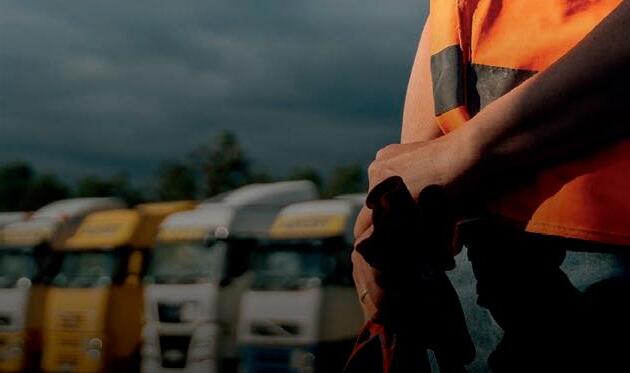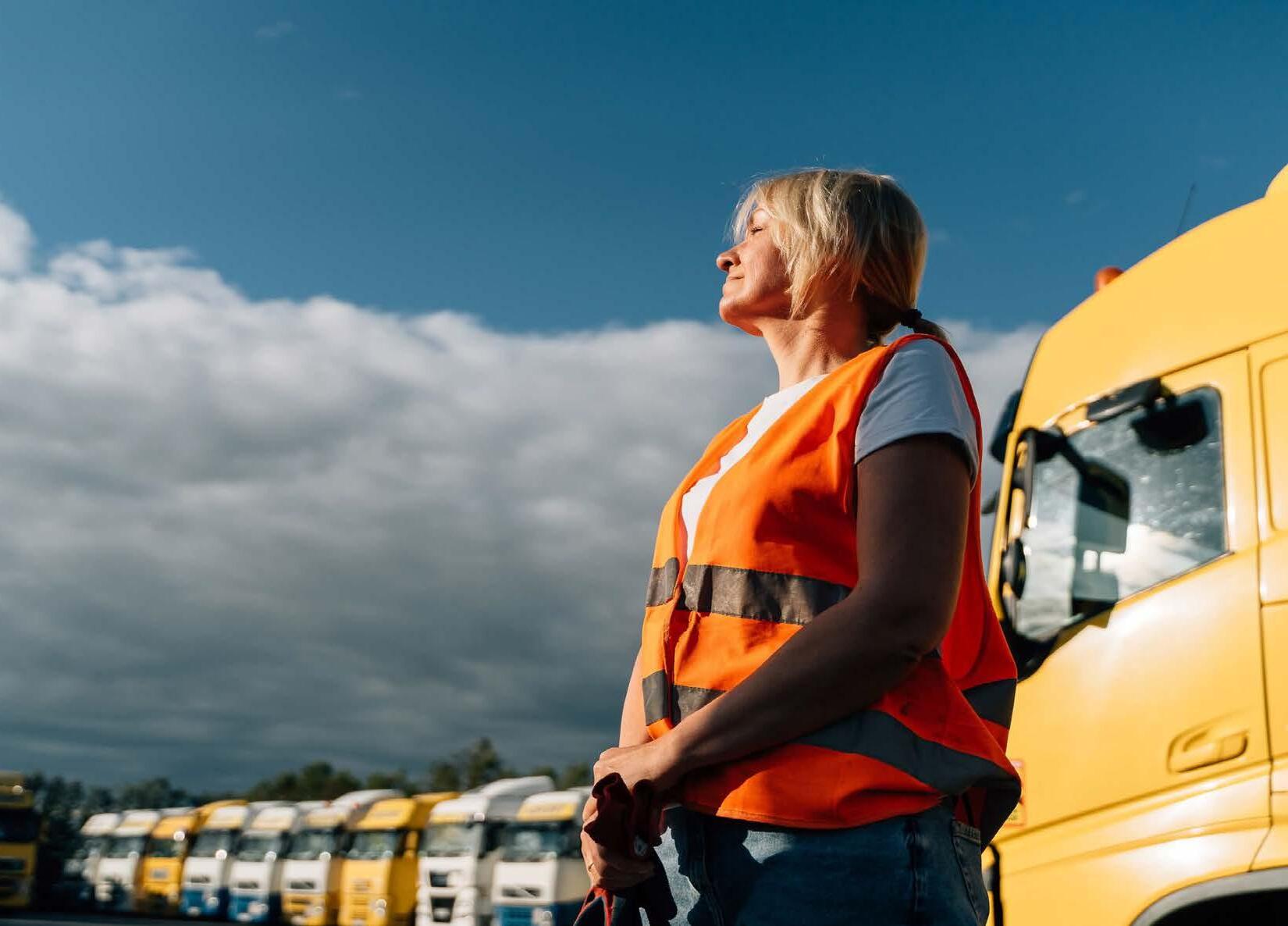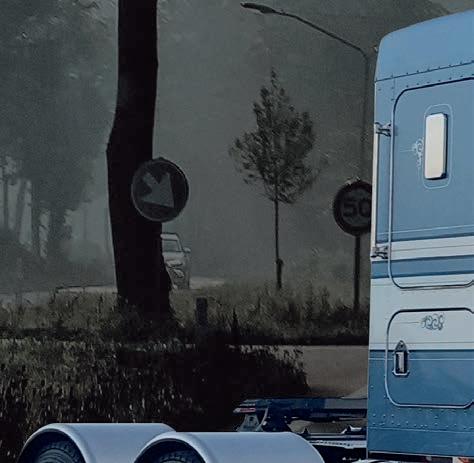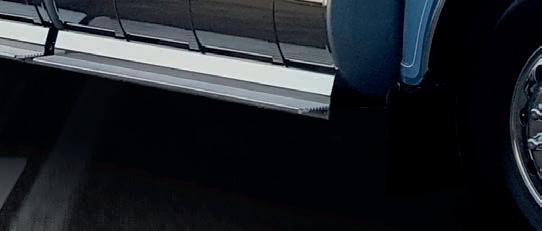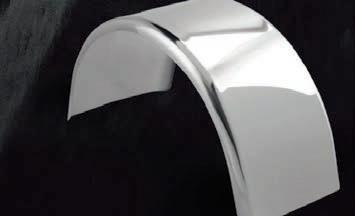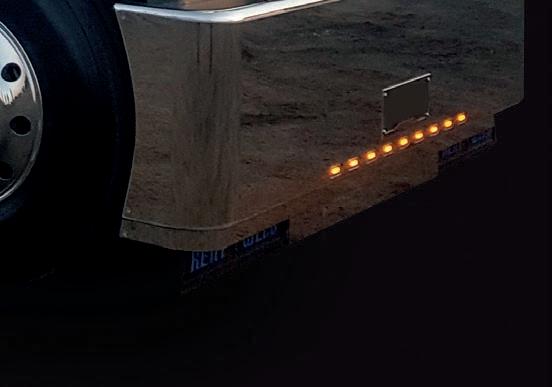


































A transport company delivering essential supplies to a remote NT community has refused to return without a police escort after one of its drivers was allegedly attacked by a group of youths.
Stanes Transport, based in Alice Springs, has been freighting food, medical, disability and teaching supplies to the town of Yuendumu for the past 15 years.
Co-owner Kylie Stanes told Big Rigs that there have been a few incidents in the area over the years, but an ambush earlier this month was a frightening escalation.
“We’ve had the truck broken into and one of our driver’s wallets stolen in the past,” she said.
“And a couple of kids throwing rocks. But this time, it was two full carloads of young people attacking our driver.”
She claims that the attack was planned in advance, with the youths throwing rocks and sticks and stealing supplies from the pallets.
“ ey had someone sitting as a lookout,” she added. “ is was planned, it was targeted, and it was an escalation.”
Stanes said her driver made four triple-0 calls during the incident, all of them going unanswered.
Without a police escort, she and her husband Mark will not be sending any more drivers back to Yuendumu.
“I haven’t been sending my female drivers out there for a long time, but now I’m like – it just can’t happen. I’m not sending any drivers at all without police.
“My drivers have a right to feel safe when they are going about their job.
“I want my drivers and the greater community to know how much we value what they do, and their safety is number one.”
She acknowledges that police in remote areas are under-resourced, but she is frustrated by their lack of action.
“ e Minister for Police was on the radio this morning and he indicated that this was a ‘community issue’ not a police issue.
“I nd that completely ridiculous.
“I understand that we’ve got issues popping o everywhere in the Northern Territory.
“But I’ve got to ght the good ght for my drivers, because what happened on Friday [March 8] is simply not okay.”
Stanes said she is speaking out about this issue partly to highlight the challenges that truck drivers face, and why they deserve respect.
“I think people have a very limited understand of what a team of drivers like ours do every day,” she says.
“ ey drive the biggest legal vehicle possible to the harshest, most remote places in Australia.
“My guys are on the front line, and they deserve respect. If they can’t do their job safely, then Australia stops turning.”
After the incident, Stanes managed to secure a police escort and a driver was able to deliver the freight that had been delayed by the attack.
She is hoping that weekly police escorts can be arranged going forward, so the Yuendumu community can get the supplies they need.
She has reached out to government representatives for help, but has so far been underwhelmed by their response.


“We’ve been contacted by the Department of Chief Minister’s O ce for a meeting,” she said.
“But I haven’t actually heard from a single minister or their o ce, or the Police Minister.”
Gwoja MLA Chansey Paech told NT News that the alleged incident was “completely unacceptable” and police were carrying out an investigation.
“Further, our local representative from the Department of Chief Minister and Cabinet who lives in the community, along with local leadership are working on a range of solutions to address the situation,” he said.
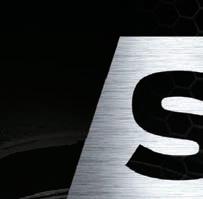




































CAM Dumesny was grateful for the news of increased access for road trains up to 53.5m into WA to alleviate more ood-related supply chain issues in the state.
But the collective lifeline from Main Roads WA, NHVR and SA doesn’t go far enough. Not even close.
“How many freight disruptions do you need to have before there’s some national leadership on the issue?” asked the frustrated Western Roads Federation CEO.
“We’ve got to start putting things in place.”
Dumesny cites the example of the recent bush res that also closed the Eyre Highway four weeks earlier.
e impacted Shire of Dundas, through which 700km of the national freight route runs, was given the grand total of $23,000 for bush re mitigation.
“ e feds are missing in action, completely missing in action, and these are trans-national freight routes.
“If we can’t connect to the east and the east can’t connect to us, that a ects businesses and it’s
already expensive enough to live here as it is.”
Dumesny said the NT is in just as much supply chain strife due to weather events impacting its supply chains.
“ ese one-in-every-hundred-year events seem to occur every month.”
Dumesny said there has been two federal parliamentary inquiries – one from the national bush re disaster in 2020 and more recently a senate-led probe on freight resilience – but he’s not aware of any outcomes for the freight industry from them.
“ ey don’t even put a BandAid on them, but just deal with the issues when they come up.
“It’s now largely just an informal network of people that make it work.”
Dumesny said the WA and NT agencies to a great job of dealing with issues as they arise, but on a national level, “it’s just crickets”.
“When you’re talking about disruption of trade between states, that is a federal problem and there is just no federal interest or leadership on it.
“ is has been going on for four or ve years, on multiple fronts.”
Dumesny said there’s more to it than just announcing investment in roads.
He said a quick pragmatic x for the road freight industry would be to install large hard-standing areas for road trains on the national highways, a similar distance apart to the air-strips (approximately 400km) in remote regions.
“So, when we get a freight disruption we can consolidate the trucks on to hardstand with toilets and if it gets desperate we can resupply them because they’re all in one area.
“During 2020 we had them spread over 700km in informal rest areas and one of them needed medication we had to get choppered out to him. at’s bloody hard when you’re spread over that distance.
“If it goes totally pear-shaped we can turn you around in that rest area and point you back home again – easy x stu .”
Dumesny would also like to see emergency-stocked containers at roadhouses that can be “cracked open” when needed with food and water.
“And put telecommunications in those rest areas so truckies can talk to family and friends
if they’re stuck. e bulk of the Eyre Highway has got no phone coverage, same as the Stuart and Great Northern Highway.”
Dumesny and his NT counterpart Louise Bilato, executive o cer of the Northern Territory Road Transport Association, are now calling on a national meeting to address the supply issues.
“We need to shift the dial and move from a ‘just in time’ to a ‘just in case’ mindset,” Bilato said.
“Without an e cient and reliable freight network, the country comes to a standstill. We are sounding the alarm and calling for urgent action.
“It is time for a coordinated approach to address the growing freight disruptions and to develop a comprehensive National Freight Resilience plan.”
Queensland Trucking Association CEO Gary Mahon said it’s a similar situation on the east coast after recent weather events.
“A key question for us is, is the Palmerston going to be replaced with something that’s more durable to the weather? Or are they just going to replace it as it was?” he said.
“Obviously, we’d expect

a key connector like that to the Bruce Highway for such a proli c produce growing area should be rebuilt to a more resilient standard.”
e o ce of Catherine King, the federal transport and infrastructure minister, didn’t respond to a question from Big Rigs about whether Canberra was doing enough to help the weather-damaged regions, instead focusing on the review of the National Freight and Supply Chain Strategy. Its goals include providing safe, secure and sustainable operations and inno-
vative solutions to meet freight demand.
e review is underway to ensure the 2019-launched strategy remains “ t-for-purse”, said a department spokesperson.
A “refreshed” strategy is expected to be released later this year.
e spokesperson said the strategy has already made signi cant achievements that are helping businesses get Australian produce from “gate to plate” more e ciently and safely: “We look forward to building on those achievements.”




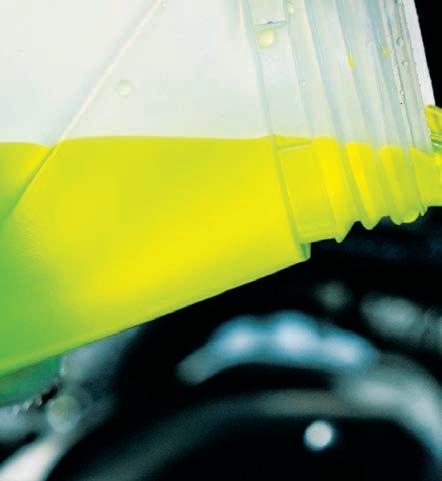














 BY KAYLA WALSH
BY KAYLA WALSH
with recycling, service and water company REMONDIS in NSW in October 2023.
Managing director of Hyzon Australia, John Edgley, said that the new truck is set to “revolutionise” Australia’s heavy-duty transport market and is an important step in solving a uniquely Australian problem: conquering heavier payloads and longer distance requirements, without emissions.
“We look forward to working with transport operators across Australia and New Zealand as we move forward with the decarbonization of our transport sector,” he added.
Edgley told Big Rigs that the truck has a range of about 400km on a full tank of hydrogen gas, depending on the terrain and the weight of the load.
“But most of our customers have committed to building their own refuellers.”
Another pain point is the price of the truck, which comes in at approximately $800$850,000.
“It’s not a ordable for owner-drivers or smaller eet owners,” Edgley admitted. “ at’s part of the work we have to do.
“ is is the rst of its kind here. is is only the 14th truck that we have built out of our plant in Noble Park.
“To make this cost e ective, we have to get volume and we have to get customer commitment and we have to get partnerships.”
He said that by the end of this year, Hyzon Australia should have 40 trucks on the road.

“ is is a fully integrated vehicle that goes through ADR testing and compliance and then is type approved, which means it’s a heavily regulated process.
ing to cover that gap,” he said.
“I think we will see more and more programs like Safeguard, that has real penalties for the top 200 emitters.
HYZON has launched a locally-made hydrogen-powered prime mover that is set to go into pilot programs across Australia later this year, scaling production in 2025.
e US-headquartered company, with an Australian assembly plant at Noble Park, unveiled the 50-tonne truck at The
a ceremony in the Kangan Institute in Melbourne on March 12. e prime mover, which comes equipped with a single stack 200kW fuel cell system and powertrain, is Hyzon’s second locally designed, engineered and built hydrogen fuel cell electric truck.
It follows the launch of a heavy-duty refuse truck, which entered into a commercial trial

He acknowledged that a major barrier to the uptake of hydrogen-powered trucks is the lack of hydrogen refuelling stations in Australia.
“At the moment, there aren’t many refuellers open,” he said.
“New Zealand has underwritten a national network of refuellers and so they’ve got four opening up in the middle of this year.
“Australia has not done that yet. ere’s a Viva refueller opening in Geelong later this year, which will be open to the public.
“At the moment, we have 11 vehicles on the road. We have the REDMONDIS garbage truck, we have some with our customer Arc Energy, and we’ve got some coaches with FMG in the Pilbara.
“We’ve got four more garbage trucks that deliver later this year.
“If we can match up with customers in a program, I think we could produce 100 trucks in 2025.”
Edgley assured potential customers that the truck is very safe to operate.
“Every safety feature that is built into modern trucks is fully functional in these trucks.
“ en in terms of managing the hydrogen and batteries, which is what people get concerned about, that is part of our testing and validation process.
“We just have to remain diligent on that. It’s one of the primary focuses of our team.”
He said the biggest challenge facing Hyzon is economic, and argued that if Australia wants to meet its zero emissions targets, there needs to be more federal and state support.
“No private operator is go-
“It’s not as if we’ve got to match the price of a diesel truck today because the cost of running diesel trucks is going to continue to go up.”
He said Hyzon hasn’t received any nancial support from the government yet, but it’s something the company hopes for in the future.
“In Australia, most of our key customers have support from the federal government through the ARENA grant program or the CFC, or both.
“As a business, we haven’t taken support yet. But I want them to invest in us, I want them to invest in helping to build out the ecosystem.”


















QUEENSLAND has paved the way for more electric trucks to carry freight on some of its major road networks.
The first phase is the creation of a Zero Emission Heavy Vehicle Map which focuses on electric heavy vehicle access from the south-east corner of the state, extending from the NSW border at the Gold Coast to Bundaberg and as far west as Toowoomba and Warwick.
The map aims to identify which parts of the south-east Queensland road network can best accommodate zero emission heavy vehicles (ZEHV) with steer axle masses of up to 8 tonnes and 18.5 tonnes on the drive axle.
An important part of the state government’s considerations, it says, has been to identify which parts of the road network could best accommodate these vehicles and facilitate access to essential supply chain linkages.
As part of a staged approach, the network map is focused on selected state-controlled roads in the south-east corner of the state where industry believes initial demand will be highest.
“This announcement will
put Queensland on the map as a leader in future electric truck manufacturing,” Transport and Main Roads Minister Bart Mellish said.
“As transport is one of the main contributors to Queensland’s emissions zero-emission heavy vehicles can make a significant contribution to meeting Queensland’s targets to reduce emissions by 30 per cent below 2005 levels by 2030 and achieving net-zero emissions by 2050.”
The news from the Queensland government came the same week that Followmont Transport was handed the keys to Volvo’s first FH Electric prime mover.
Managing director Mark Tobin, who ordered the truck in April 2022, was excited to hear that the road network was expanding to make the adoption of EV trucks easier.
“The investment in this truck reinforces our commitment to driving positive change and supporting a sustainable future for generations to come,” Tobin said.
“Together we can drive positive change and build a cleaner, more sustainable future for
the next generation.”
Followmont’s FH Electric prime mover will be tasked with shuttling trailers between the company’s Eagle farm depot, servicing major accounts around Brisbane.
It will also run overnight linehaul to Followmont’s Toowoomba and Sunshine Coast depots.
The 540kW, 666hp truck is currently rated to 44 tonnes and has a range of up to 300km on a single charge.

A 600kW charger has been installed on site at Followmont head office for overnight charging, with plans to install charging solutions further afield as the company seeks to increase reach and range.
Speaking at the handover of Volvo’s first electric prime mover, Tobin said he wasn’t worried about ordering the truck before it became legal to drive them on Queensland roads.
“One thing Followmont is committed to, it doesn’t matter whether it’s trucks, or it’s when we do our buildings, but every time we touch something, it’s about the future, and I think that’s what life’s
about,” Tobin said.
“We’ve got to build for the future, and our kids are the future. Innovation in any business is what’s going to make a difference.”
Tobin said he was “never scared” to make the leap into electric vehicles because of the long-standing relationship and trust the business had built up with Volvo over the years.
“We’ve got to think about sustainability, we’ve got to take it seriously and that’s what this is about.
“This is a journey and we wanted to be first, not last. If anybody has a fleet, and a large fleet, you need to take this seriously because you won’t be here in the future if you don’t.
“Ben and I are 100 per cent committed with our Followmont team. We’ll continue buying them [electric trucks] and we’ll continue to do business with the Volvo Group.”
Martin Merrick, president Volvo Group Australia, said he was thrilled to hand the keys over for the company’s first electric prime mover to Followmont.
“We see partnership as the new leadership, and before Mark or Ben knew this truck could operate legally, they put their hand up and took the leap of faith to say they’re on board, we’ll do it together,” Merrick said.
“We really appreciate the partnership that we’ve had
with Followmont Transport for many years, and we are really looking forward to the future.
“What we are seeing today is a major step on our journey toward fossil-free transport solutions by 2040.”
Merrick also reiterated Volvo’s commitment to build BEVs at the Wacol HQ in Queensland and thanked the state government, the Department of Transport and Main Roads and Sal Petroccitto, the NHVR CEO, for their part in the passing the legislation.
“That’s one step, but we really need to support the whole industry with incentives to accelerate the adoption rate of battery electric vehicles,” he said.
SYDNEY
510 Victoria Street, Wetherill Park NSW 2164
Ph. 02 9756 6199, email: isri@isri.com.au, www.isri.com.au
BRISBANE
3/120 Gardens Drive, Willawong QLD 4110


Ph. 07 3275 2044, email: sales@isribrisbane.com.au, www.isribrisbane.com.au
MELBOURNE
Unit 1/569 Somerville Rd, Sunshine West VIC, 3020
Ph. 03 9311 5544, email: sales@isrisunshine.com.au, www.isri.com.au
MACKAY ,
Ph. 07 4952 1844, email: admin@isrimky.com.au, www.isriseatsmackay.com.au
PERTH R , WA 6106
Ph. 08 9362 6800, email: info@mmtisri.com.au, www.mmtisri.com.au
DARWIN
Mobile Sales and Service
Ph. 08 8927 0986, email: info@isridarwin.com.au, www.isridarwin.com.au
ADELAIDE
TAMDELE, 21 Hakkinen Road, Wingfield SA 5013
Ph. 08 8347 1222, email: sales@gitsham.com.au, www.gitsham.com.au
NEWCASTLE/HUNTER VALLEY
Unit 2/13 Hinkler Ave, Rutherford NSW 2320
Ph 02 4932 0600, email: sales@hvss.com.au www.isri.com.au

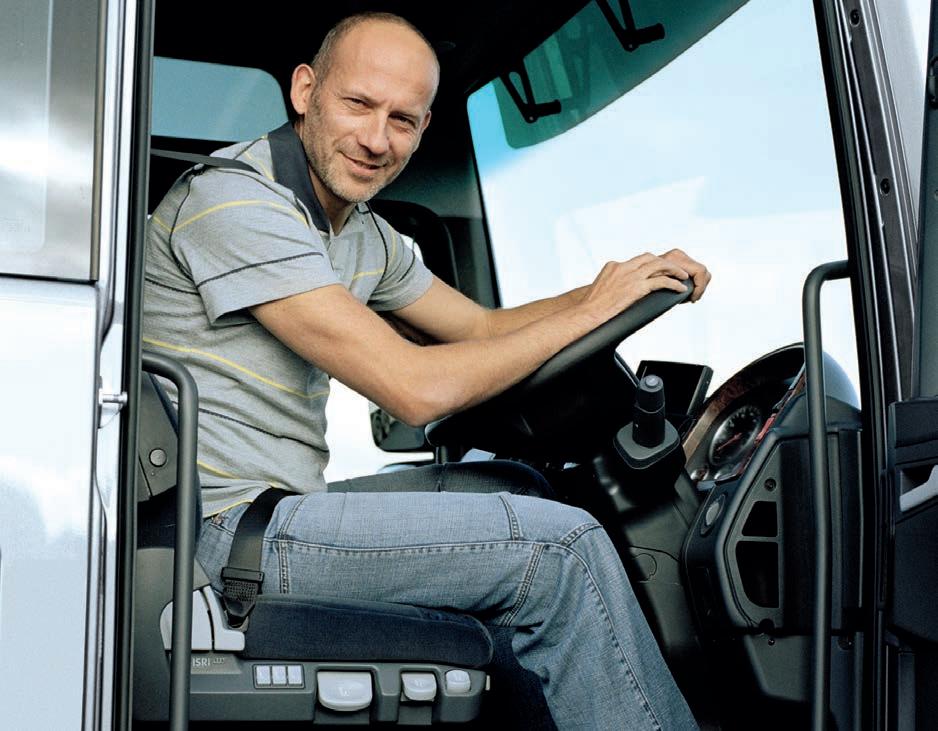











CENTRAL Queensland livestock transporters are set to bene t from $500 million of upgrades to priority road corridors to support the state’s beef industry.
In a statement announcing the news earlier this month, the Queensland government also con rmed the feds will kick in $400 million of that total as part of the mid-year economic and scal outlook.
e state government, in partnership with Canberra, will work with seven local government mayors and key industry stakeholders on the identi cation of short, medium and long-term beef road priorities to inform a 10-year Central Queensland Beef Roads Investment Strategy. is includes the Mayors of Barcaldine, Central Highlands, Gladstone, Isaac and Rockhampton Regional Councils and Banana and Woorabinda Aboriginal Shire Councils, who have been ad-
vocating for infrastructure investment to improve the roads forming part of the state’s beef supply chain.
To kick start the initiative, an early works package is being developed with the Miles government funding contribution, prioritising the following projects:
• Pave and seal sections along Clermont-Alpha Road in Mackay/Whitsunday and Central West districts.
• Pave and seal and widening of oodway along Alpha-Tambo Road in the Central West district.
• Pave and seal in sections of the Fitzroy Developmental Road between Bauhinia – Duaringa in the Fitzroy district.
• Pave and seal section along May Downs Road in the Mackay/Whitsunday district.
Construction is expected to commence progressively from 2024-25 and these
said Queensland Transport and Main Roads Minister, Bart Mellish.
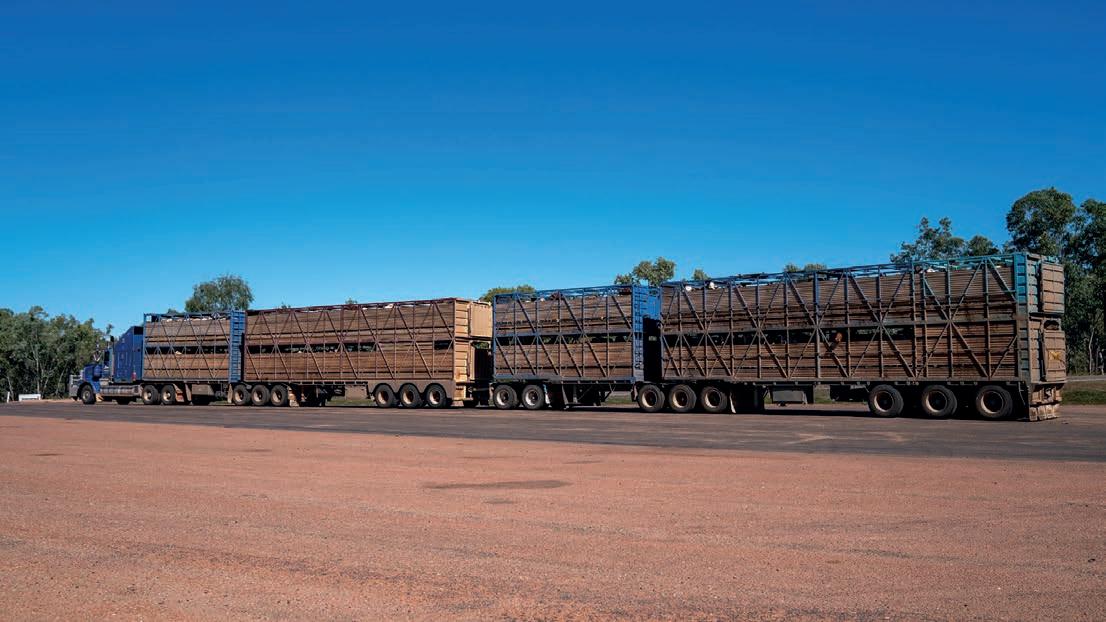
Route (IFR), also known as the Second Bruce.
“ e road upgrades to be proposed under a 10-year Central Queensland’s Beef Roads Investment Strategy will provide safer and more efcient transport solutions for this nationally-signi cant industry and increase economic opportunities for the region,”
Queensland Trucking Association CEO Gary Mahon said the commitment from the state government is a good start.
“We’re pleased to see they’ve honoured the commitment of the previous government,” Mahon said.
“Certainly, those roads in that system very much justify progressive investment and we would be hoping we see a
further commitment to the Inland Freight Route which will connect up with those beef roads to improve safety and e ciency across the centre of Queensland.”
Mahon is “quietly hopeful” that the IFR features prominently in May’s federal budget.
“We’ll be watching intently to see if the IFR gets the priority it deserves.”
Infrastructure Minister Catherine King hit the pause button on the proposed $1
billion Second Bruce late last year and ordered a business case study that would decide the route’s fate.
e previous federal government had promised to cofund the project on an 80:20 split with Queensland.
Queensland’s beef corridor network stretches across nearly 218,000 square kilometres and runs from east to west across Central Queensland. is strategic web of roads help contribute $1.7 billion to the Australian economy.

VOLVO Trucks has taken the wraps off the highest horsepower FH16 it has offered in Australia to date.
Volvo Trucks Australia has now announced that the entire D17 powertrain offering with power options up to and including 780hp will be launched locally from mid-2024, making the new FH16 “Australia’s most powerful on-highway truck”.
The powerful new D17 engine was launched in Sweden to much acclaim in January 2024 with a new range of horsepower ratings stretching from
600hp to 780hp.
Along with the added power ratings for Australia, the updated FH16 also sees a significant jump in torque.
The 600hp variant now offers 3000Nm of torque, while the 700hp offers 3400Nm, and the range-topping 780hp option brings 3800Nm to bear.
The 17-litre, Euro 6 powerplant shares the same basic architecture as the 16-litre engine it replaces with the extra capacity resulting from an increase in cylinder bore.
In pursuit of efficiency and cleaner operation, the
engine also features a new fuel injection system, low friction cylinder liners as well as wave top pistons to ensure optimised combustion.
All power ratings are HVO (hydrotreated vegetable oil) compatible.
“A world of possibilities has been built into this engine platform,” said Shayne Commons, director of product and Pperformance, Volvo Group Australia.
“Highly efficient drive trains capable of using alternative fuels will be a key part of our path to net





zero emissions.”
“More power gives us the option of gearing our trucks for more efficiency on highway, more torque means less gear changes and more top gear time.”
Commons said driver feedback so far has been overwhelmingly positive, especially in regard to holding road speed in undulating terrain.
“Drivers will want to drive this FH16.”
The new FH16 and D17 engine will be available to order for Australian customers from July 2024.




















Barb Harvey, the beloved former outback operator and co-owner of the Little Topar Roadhouse, passed away in Broken Hill on March 12, aged 80.
Heart-felt tributes have poured in from all over Australia on social media for the no-nonsense former publican who ran the Little Topar for 30 years with husband Colin,
who died in 2022, aged 84. Barb and Colin retired to Broken Hill in 2018, but her legendary hospitality lived on in the hearts of the thousands of truckies who passed through the Little Topar and were lucky enough to get to know her.
Big-hearted Barb was like a mum and grandmother to many; an instant lifelong friend to everyone she met.
“One of the kindest, gentlest but toughest people


I’ve ever had the privilege of knowing – she will be fondly remembered,” wrote Kelly Finch on Facebook.
“Barb actually saved my life when I was a kid. She was at home picking up a load of wool and I choked on apple. She sprang straight into action with her hand down my throat and managed to get it out.”
Nephew Jerram Wetherell told Big Rigs he had a lifetime of cherished memories


ey stretch back to ridea-longs as a child with Barb in her wool-carting days behind the wheel of her G88 Volvo into White Cli s.
Barb and Colin, who were inducted into the Shell Rimula Wall of Fame in 2005, would also cart general freight into the bush and even had a mail run at one stage that had expanded as far as Adelaide.
Barb would also often take her own children with her on the runs before they were old enough to attend school.
Renowned as a hard worker throughout the NSW outback, Barb could load wool






“quicker than any man” and single-handedly rolled drums of fuel, bales of hay and wool to load her truck.
According to her pro le on the Wall of Fame website, she was once bogged in her truck and had to walk 30km through the rain to get help.
Once, surrounded by bush res, she drove her truck to her destinations to ensure the supplies were delivered despite recommendations that she shouldn’t.
When asked to share some stories from her Topar days, Wetherell responded by saying: “I wouldn’t know where to start, there were that many.
“She didn’t take any bullshit. She turned it [the Topar] into a no-swearing pub. She didn’t like bad language, sort-
ed the shit out, and ran a top little business.”
Wetherell loved her regular “cracker nights” at the Topar when farmers, and other locals, would come from near and far for the reworks spectacle and camaraderie.
“She used to pay for that at her own expense just to see people happy.”
More recently, Wetherell said he was grateful for the chance to drive her the 1000km from Broken Hill to Wagga Wagga in January to see family.
“We joked, we cried and we shit-stirred each other for 10 hours so that was a nice memory, my last memory.”
Barb is survived by son Rodney and daughter Deborah and several grandchildren.


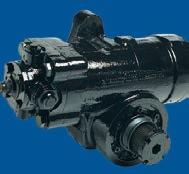







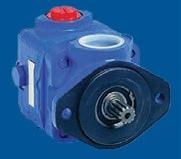







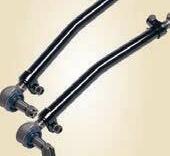





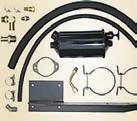













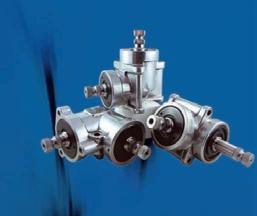



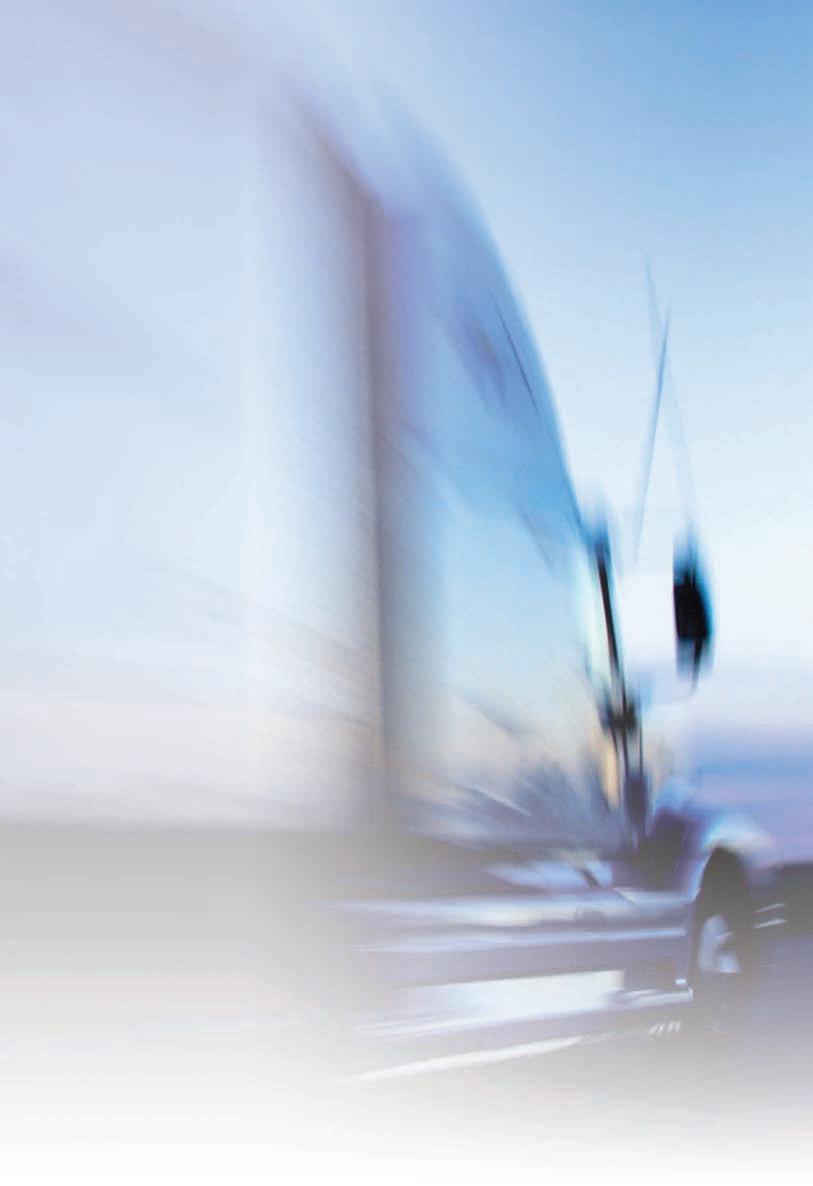
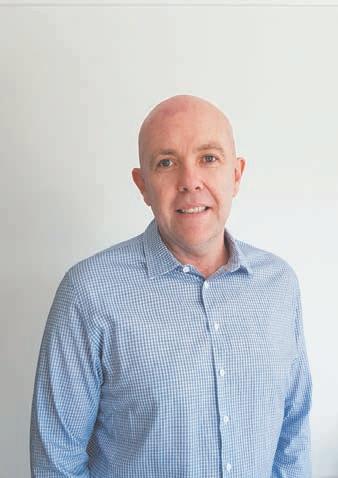
al public think if they discovered how lax the system has become?
According to the comments , Queensland motorists are sharing the roads with too many inadequately trained drivers, signed off by equally inept state assessors. One ex-TMR driver examiner told us that he’d seen many employees who had never driven a truck before go with the head assessor for their own HV licence upgrade. Then, the very next day they were working alongside him assessing HV applicants. “Just dumbfounding,” he wrote.
Is this going to change? Not if TMR has any say, it seems. When we put these issues to them, they didn’t seem to share our concerns at all.
“While big business want a steady flow of drivers, the industry will struggle to raise competency levels,” said one driver.


readers attesting that they had witnessed the filthy conditions themselves.
“It’s been like for ages, dirty toilets and showers,” said Noel Woolley.
“Pull up within 20 metres of the toilets and the stink nearly peels the paint off your truck,” added Brad Stokes.
Chris Laurie chimed in: “Someone ought to report them to department of health, because that bathroom is bloody disgraceful.”
BP Murrurundi caused a stir on our Facebook page – with many
BIG Rigs readers were outraged by our story about the failure of a SA Safe-T-Cam system to adjust for daylight saving changes, which ended in a court summons and expensive legal bill for a distraught interstate truckie.
The driver has since had the charge withdrawn and been awarded part costs against the NHVR.
However, many of our readers thought that he should have received full costs – and been compensated for the stress he had been put through.
Others commented that it’s a common occurrence for servo toilets to be in
an unacceptable state, and truckies are being treated like “second class citizens”.
Andrew Freeman said: “This needs to be put out there more. We work hard and do long f*cking hours, so why should we be treated like shit?”
“Maybe all the filthy ones need to be boycotted,” wrote Cin Rutland. “Truckies deliver their food and fuel and merchandise, so without the truckies just how much will they lose? Maybe that will make them look after all the drivers.”

A column by esteemed trucking journalist Steve Brooks lamenting the hoops older drivers like himself are forced to jump through in NSW really struck a chord with our readers.
Many of them agreed with Brooks that the NSW system, which requires drivers over the age of 70 to undertake a driving test every year to keep their MC licence, is unfair.
“They up the the retirement age, and then make it harder for older people to stay behind the wheel! You can’t make this shit up!” wrote Nathan Wells.
“Doesn’t experience count to any degree?” asked Damo Lear.
Others gave examples of older drivers who are more than capable of driving a big ger truck.
“My dad gave up driving triples at 81 and up until he stopped he could do it bet ter than most,” said Shaggs Franklin.

Truckie Arthur Curran, who is 47 years on the road, added that he’s driving and working the late shift “without a problem”.
“I’ve watched some drivers in their 70s handle rigs better than most,” echoed

recently.
In the piece, the QTA argued that the Government “need to start building roads for trucks” rather than building roads for cars and letting trucks use them.
Many of our readers agreed with this, sharing their thoughts on our Facebook page.
said truckie Bruce Shelton.
“Put decent gravel on them so that the roads don’t melt when it’s hot, and it would also help when it’s raining it wouldn’t be like glass to drive on,” suggested Janine Browne. “And paint the lines yellow instead of white.”
“Every driver should be compensated for mental anguish. Every fine they f*ck up,” agreed Rhiannon Lindley.
“How can ‘partial costs’ be considered reasonable,” wrote Michael Leslie. “They should go for full costs including lost time, time spent preparing defence and mental anguish.”
Others said that unjust fines like this one are far too common in the transport industry, and something has to change.
“It’s disgusting how we are treated as an industry. We are treated as criminals and as an ATM for the government,” said Regan Bow.
“Everyone park up in protest. It’s getting beyond a joke and just too hard,” said Bruce Fekete.
“They need to go back to when the government built the roads to a standard – not a cheap-ass contract who subs the work out to the cheapest contractors, who goes broke and work is not finished or falls apart after first shower of rain,”
Tim Small said that all civil engineering cadets should be required to spend 12 months in Europe, learning “how to construct and maintain roads the right way.” He added: “We have the worst roads of most first world countries.”



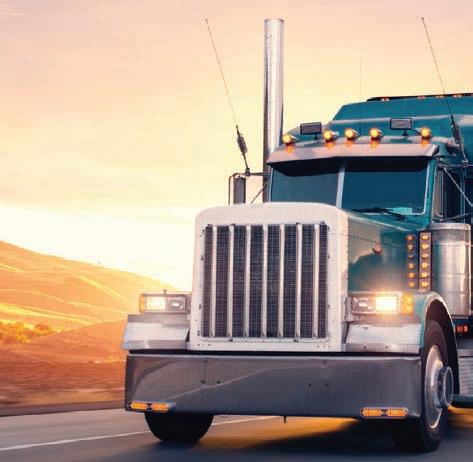









Electric eet trial
Team Global Express (TGE) has begun an electric truck eet trial in Sydney.
e “ground-breaking trial”, in partnership with the Australian Renewable Energy Agency (ARENA), sees TGE replace a third of its Western Sydney eet with a total of 60 electric trucks to deliver parcels to customers around the metropolitan Sydney area.
To date, 43 out of the 60 ordered trucks have arrived at the depot which will roll out across the streets of Western Sydney.
TGE will receive 36 Volvo eFLs and 24 Daimler Fuso eCanters in total to facilitate the ve-year trial.
Fuso recall
Daimler Truck Australia Paci c has issued a recall notice for 533 Fuso Shoguns.
e a ected units are in the year range 2021-22 and the variants are FP7, FS7, FU7 and FV7.
e recall notice said the power distribution module wiring harness may have been connected incorrectly to the positive and negative fuse and relay box terminals.
As a result, a mounting bracket could interfere with the wiring, causing the power distribution module to short circuit. is may result in a vehicle re.
Owners of a ected vehicles are advised to contact their nearest authorised Daimler commercial vehicle dealership to arrange to have the work carried out as soon as possible, free of charge.
Speed limit increase
Truckies will be allowed to travel at 90km/h – up from 80km/h – on the WestConnex in Sydney from April 20, but the productivity increases come at a price, reveals a damning new tolls report.
According to the interim ndings from a comprehensive tolls review, Sydney drivers will fork out $195 billion in tolls over the next 37 years, with truckies paying signi cantly more than motorists for each trip.
WestConnex accounts for about 52 per cent of that gure. Drivers on the M4 will be hit the hardest, paying WestConnex $24.6 billion in tolls over that period.
Driver underpaid
e former operators of a Queensland transport and logistics business have been ordered to pay a total of $19,922 in penalties and back-pay after the Fair Work Ombudsman won a case against them in court.
Jatinder Singh Bassi, a sole trader who operated Bassi Group Transport, and his wife Satty Bassi, who was involved in operating and managing the business, each had penalties of $5,328 imposed on them.
On top of the penalties, Jatinder Singh Bassi has been ordered to pay the driver the $9266 he owes him, plus interest.
AFTER being the rst on the scene of a horri c fatal crash, this Victorian truckie didn’t think he could ever return to trucking – but thanks to the support of those around him, he’s in a much better place.
Long-haul truck driver Andrew Mifsud, who works for Sargeant Transport, developed post-traumatic stress disorder after the December 2022 incident.
With the support of those around him, he’s now returned to trucking, but in a di erent capacity, working as a driver trainer at Sargeant Transport.
Speaking of the 2022 incident, Mifsud recalled: “What I remember, I’m coming from Kyabram into Tatura. I’m seeing this white car and there was an oncoming truck that hit the car –that car didn’t give way.”
Both he and the other truck driver stopped to give her assistance. ey tried desperately to help the young woman. Sadly she couldn’t be saved.
“He was on the phone with 000 while I was trying to get in the car. I still see the tear in her eye so she didn’t die straight away. I feel she didn’t die alone either because there was me and this other man. It was very hard,” Mifsud explained.
After that, Mifsud drove back and thought he was

okay – that was until the next day, when it really hit him.
“To be honest I was alright, until the next day.
e next day was a di erent story. I got in the truck, I was on the way to Bendigo, halfway there, it just wasn’t the same, I started tearing up,” he said.
“I couldn’t deal with work, it was hard enough at home, losing my dad three weeks prior. I was mourning this girl before my dad.”
As driver training manager at Sargeant Transport, Paul Bracker, explained, “Andy called us the next day and said, ‘Hey, I’m not right’. We went through
with our injury process to ensure that we can get him the help that he needs.”
Mifsud was appointed a case manager named Kathy Anderson from personal injury insurer Employers Mutual Limited (EML).
“Andrew’s injury was really tough to read. He tried so desperately to save her and he just didn’t want to talk about it – and it was really, really tough for him to open up. We needed to nd him phycology and fairly quickly,” she said.
“Andrew was just willing to do whatever he needed to do to keep on putting one foot in front of the other. He eventually returned to
work and it was such a massive moment for him.”
Mifsud says he credits Anderson with changing his life. “If you don’t talk… You can’t hold it in, it just explodes. You get it o your chest and you feel lighter –because I was gone. I was going to give notice, I was out,” he said. “ e support I got from my team, it’s changed my mind.”
When an opportunity arose for Mifsud to join the Sargeant Transport driver training team, Mifsud retrained as a driver trainer.
“I’m still learning. It’s hard coming out of the truck and trying to teach someone else. You’re reaching for the
foot pedal trying to stop the truck,” he laughed.
“I get pleasure out of it too because I know I can help him or her. I was going to semi-retire or retire, I didn’t want nothing to do with roads. at’s all gone out the window now.”
Mifsud’s advice to other injured workers is to talk, seek help and never give up.
“Anybody who’s going through what I’m going through, you’ve got to talk. Don’t hold it in. And hopefully you nd someone like Kathy that can make you talk,” he said.
Mifsud’s inspiring story was also celebrated as part of the WorkSafe Victoria Awards on February 29, which recognise excellence in workplace health and safety and return to work.
From 100 nominations received, Mifsud was among 16 nalists shortlisted across six award categories. He went on to be named a joint winner in the Return to Work Achievement award, alongside Helene Visser from Tidda Counselling, who also overcame a signi cant mental injury to get back to work.
Mifsud believes that for people in similar situations to him, returning to work is the best thing you can do.
“If a company can give support to a worker, I think it’s a big step. I feel this award shouldn’t be only for me, it should be for the people around me.”
NOT all heroes wear capes –and this local transport legend is a shining example. Fed up with the filthy state of the local rest area amenities, he’s taken it upon himself to clean and maintain them.
Truck driver Tracey Connaughton got in touch with Big Rigs wanting to give Barry Smith at Barry Smith Transport a shout-out.
The rest area at Dirranbandi, a Queensland town located near the border of NSW, had been in quite a sorry state for some time.
Based in Broadford, Victoria, Connaughton and her partner Laurence Harris are owner-drivers, and currently stop at the site twice a week with their Kenworth T900 and road train, as they deliver pipes from Melbourne to Rockhampton.
Coincidentally, when Big Rigs published a story about the poor state of the facilities in November last year, Connaughton had also contacted the local council – but to no avail.
“I had contacted the St George shire to ask why they are not being cleaned and why
the staff employed to clean them were sitting under the tree in their car doing nothing! I sent pics and they assured me they would be cleaned,” she said.
After a seven-week break over Christmas, the couple recently went back out on the road. When they arrived at the Dirranbandi rest area, the toilets and showers were spotless.
Interestingly however, they say the local council wasn’t responsible. Instead the couple says it was local transport veteran Barry Smith of Barry Smith Transport, who got the job done.
Connaughton says a lot of grain and cotton transporters stop at the site, which has three showers and three toilets. “It’s so handy. There aren’t many roadhouses on the run we do, so we shower there.
“I know people can be feral and don’t clean up after themselves, yes there was that – but the shower curtains were also mouldy and the whole area was filthy. I don’t mind old or cobwebs, but I don’t like having to shower in filth!”
According to Connaughton, two council workers had been heading to the site. “I told them there was a tap off, and a

week later it was still off,” she said.
“Barry himself helped a young lady scrub and clean the toilets and showers, and she is now maintaining them. He got sick of the state of them, and he’s organised someone to maintain them.
“When I saw her cleaning I told her what a great job she’d done. We were like wow, they’re clean – that was last week and then this week again.

I said thank you so much from so many truck drivers for the job you’ve done.
“All the cleaning products she had there would’ve cost a fortune too!”
However, Balonne Shire Council chief executive officer Matthew Magin, recently told Big Rigs that the facilities are being cleaned and maintained.
“We clean these facilities at the Dirranbandi Truck Stop three times a week and they are
easily the most time consuming of all the amenities blocks for our staff,”he said.
“Our team is consistently confronted with unacceptable scenes at this location, as they are covered in grease and excrement by users who don’t respect these free facilities.
“We ask that people respect the free services on offer, as these facilities at the truck stop are provided for their travelling convenience.”



Our latest Quon range offers enhanced performance, driveability, innovation and a raft of new and improved safety features. Intelligently designed and precision crafted in Japan, the UD Quon is purpose built for tough Australian conditions.
With their proven strength, strong pulling power, superior turning circle, and smooth driveline, UD Trucks deliver like no other. Plus, for complete peace of mind, it’s all backed up by Australia’s best service network. Our enhanced Quon not only delivers the very best, but puts people and their safety rst.

Going the Extra Mile
To nd out more, contact your UD Trucks dealer on 1300 BUY A UD or visit udtrucks.com/australia












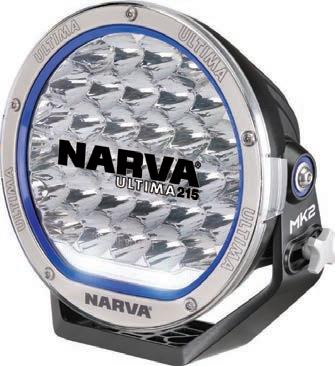































































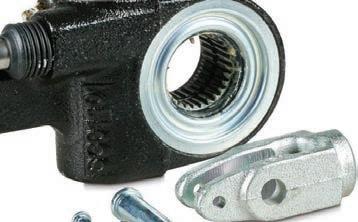


























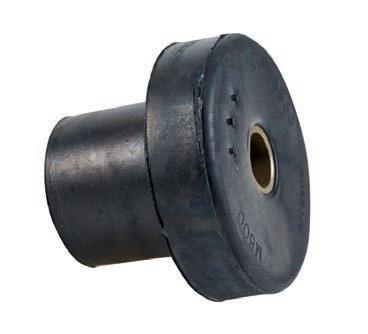


















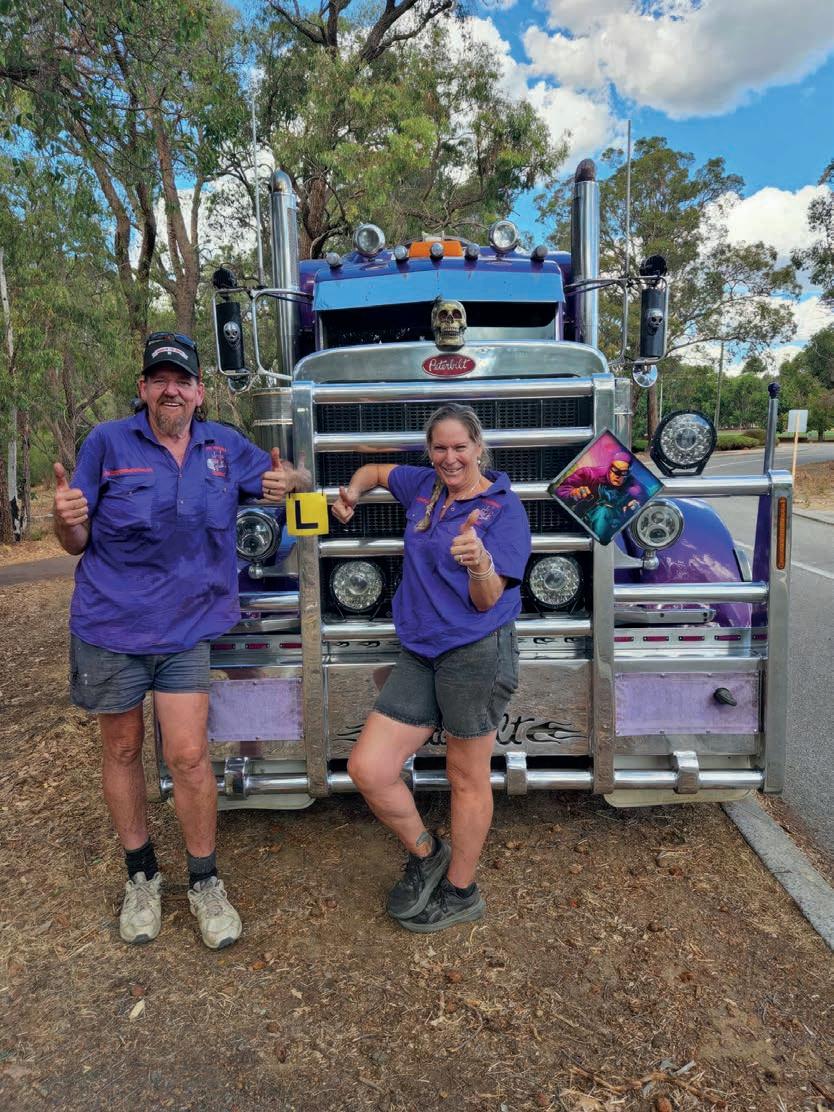
most shouldn’t be here, and she has been with me through this whole journey.
“I’ve never had anyone who has stood beside me the way Wendy has, and getting married has made us even closer.”
He said Wendy’s devoted care, combined with lots of rest, has helped him to make good progress in his recovery – but he still has a long road ahead of him.
of trucking.
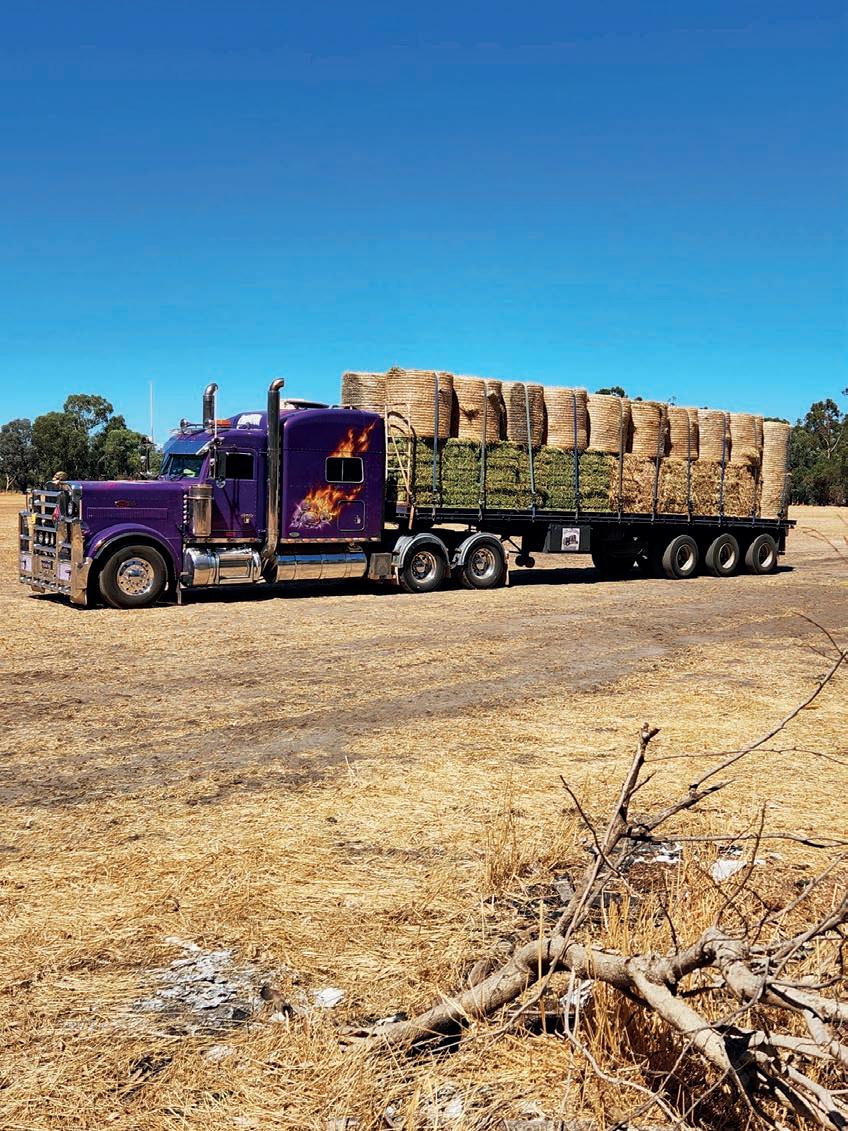
Sadly, he won’t be behind the wheel of his famous 2008 Peterbilt 379, e Phantom – but his wife Wendy will be. “I have mixed emotions about being back on Outback Truckers,” Sludge told Big Rigs.
“I’m glad to be back, but I’d like to be driving the truck.
“I know I’m not ready to drive because it would wear me out and I would probably hurt myself, but it’s tough.”
Wendy, 56, who has a truck licence but hasn’t driven a truck
Truckers for Season 10, and Sludge hopes he will be able to shoot a third if his health allows.
“ e way I’m going, I’d like to start driving a little bit again in the next month or two.
“I just had a discussion with my physio, and she’s going to talk with my occupational therapist and we’ll come up with a way for me to do that.
“I would love to do a third episode of the show with me driving, but if I can’t drive, I’ll be paired up with a mate.”
of doing the show, really, but it was huge for them to do that for us,” he said.
“ at’s something we couldn’t have paid for, and it was very special to us.”
Wendy, who is a former police o cer but has worked as a personal trainer for the past 15 years, wanted to postpone the wedding because of her partner’s accident.
“She wanted to put it o but I said ‘No way!’” Sludge continued.
“I’m lucky to be alive, I al-

“ ere have been a lot of ups and downs,” he said.
“I was doing really well and then I fell o the perch again.
“I’m o most of the painkillers now, but still su ering from vertigo and fatigue.
“ e fatigue is killing me – I can only be active for a couple of hours and then I will have to rest for a couple of hours before I can do anything again.”
Sludge, who su ered a fractured skull and a bleed to the brain in the accident, is also struggling with memory loss.
“It feels like I’ve lost the last year of my life,” he said.
“ ere is so much I don’t remember. Even parts of my wedding day.
“It’s slowly getting better, but Wendy still has to come to everything with me.
“I went to the doctor’s o ce the other day and she had to write me a letter to bring with me, so I wouldn’t forget what she said.”
Despite his challenges, Sludge been getting out and about a bit more recently.
“It’s hard because people want to come up and talk to me, and I love talking to people but it tires me out now.
“ ankfully people have been really good. We went to Kulin Bush Races and they just said hello, that it was nice to see me looking well, got a photo with me and that was it.
“I just can’t handle when

last year.
they want to ask a lot of questions. He added: “When I’m out with my friends, we don’t talk about what’s happened to me.
“I can take my mind o it, or if I’m worn out I can sit out of the conversation a bit and recover.”
Although Sludge misses being in the driver’s seat of e Phantom, his brush with death has given him a new perspective on trucking and life in general.
“ e accident, and losing a mate of mine in New Zealand, have made me realise that life is short,” he said.
“I never thought I would say I didn’t want to drive full-time anymore, but I really don’t.
“I will do it to earn a few dollars and to keep me sane.
“But I think the days of me being on the road ve days a week are over.” After spending decades on the road while his children were growing up, he wants to prioritise spending time with his grandkids.
“I love being around kids, so I want to spend a lot of time with my grandkids while still doing a bit of work,” he said.
“It’s all about balance.”
Outback Truckers still casting
Though filming is well and truly underway for season 10 of Outback Truckers, which is due to air later in the year, the team behind the show are still actively casting for talent.
Prospero Productions was recently on the ground at WA’s Mack Muster and Truck Show on March 24 at Quarry Farm in Byford, WA, as casting continues.
“We’re always on the hunt for new stories and new truckies. We’re looking for interesting characters, interesting journeys and people going remote,” said story producer Claire Falkiner.
The last season of Outback Truckers aired in 2021 so the next instalment has been a long time coming. Since it was launched, the show has aired in over 120 countries.
As per previous seasons, season 10 will consist of 13 one-hour long episodes.
If you think you’ve got what it takes to be on season 10 of Outback Truckers – or know someone else who’d be great to watch, email c.falkiner@ prospero.com.au.


30 YEARS OF TRUSTED. RELIABLE.
ESTABLISHED IN 1994
LAUNCHED IN AUSTRALIA IN 2013

TRP®BRINGS A RANGE OF AFFORDABLE, QUALITY PARTS FOR YOUR TRUCK AND TRAILER


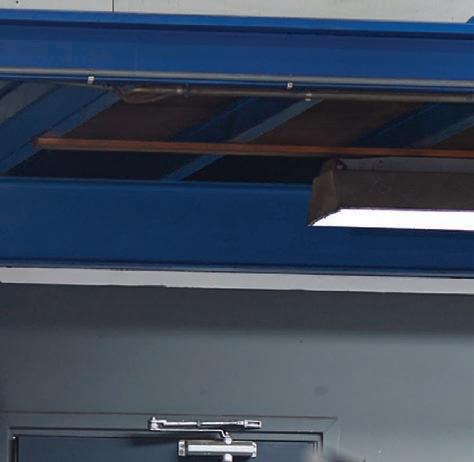













Five years after testdriving the first iteration of the eCanter, our correspondent was eager to get back behind the wheel of its successor.BY GRAHAM HARSANT
BACK in 2019 I test drove the then brand-new Fuso eCanter. So new in fact that the info screen was in Japanese. is was the rst full electric truck I’d driven and to say I was blown away was an understatement.
I’ve driven quite a few EVs since 2019 but that rst eCanter has always remained fondly in my memory – a rst love sort of thing – and I’ve yet to drive anything in the segment that I’ve considered better in the intervening years.
Now however, I’m behind the wheel of the brand new, second-generation eCanter and again I have Daimler’s Romesh Rodrigo, with upgraded title, riding shotgun.
From that rst edition, single model, Fuso has gone the whole hog with gen-two, o ering no less than 14 variants: four weight ratings from 4.5-tonne GVM to 8.5-tonne GVM, six wheelbases, three battery con gurations and a choice of City or Wide Cab. ey have ePTO options available as well.
Topping the safety features list in my book is Approaching Vehicle Alarm System which creates arti cial vehicle sounds when running forward at low speed and in reverse. If you get a fright when a person sneaks up behind you, imagine tons of truck doing the same!
ere’s the latest tech versions of Advanced Brake Assist, Electronic Stability, Lane Departure Warning and Active Side Guard Assist. is last one now, not only warns if someone or something is down the left side of the truck, but will override the drive and stop the vehicle if it senses an
imminent collision. To round things out there’s now LED head and tail lights.
With the odd Tesla and a very public EV truck going up in ames recently, it’s not surprising that Daimler have invested heavily in battery safety. Firstly, there are the impact crash sensors that shut o the high voltage supply from the HV batteries to ensure no electric current is released.
ere have been re tests, batteries have been overcharged and drowned -everything to ensure these vehicles not only meet, but exceed European Community battery regulations.

e battery packs are set well within the side perimeter of the vehicle, not only for added safety but to allow added exibility when adding body types to the chassis.
For those not in the know, the batteries in trucks (and cars) are actually a whole bunch of small batteries grouped together. In the Gen 1 – and many competitors today – cooling and/or warming was achieved by a single ‘blanket’ wrapped around the whole. In Gen 2 there are channels around each individual battery to minimise re risk.
ese latest battery packs are lithium ion phosphate which not only have signicantly less dependence on raw materials such as nickel, cobalt and magnesium, they have a lower re risk compared to other types of technology. ey are also expected to give longer life.
To illustrate the advances in battery technology, Gen 1 had 88kW giving a range of 100km. e same single battery is now only 41kW in Gen 2, but still gives that 100km range. And now, depending

on choice of vehicle you can have up to three batteries with a potential range of 300km, depending upon how you drive it. If that doesn’t diminish range anxiety, I don’t know what will.
ese new batteries also have up to 95 per cent usable capacity, against around only 70 per cent of the old lithium Ion. Testing has shown that they retain maximum charge much longer. ey also have a liquid conditioning system which is for cooling, and heating as sometimes you need to bring the battery up to optimised temperature.
e Gen-2 eCanter can now be charged on both AC and DC, so you can take one home and charge it in the shed – provided you have three-phase power available.
e other big news from Fuso is the world-beating eAxle where engine and di are one unit, doing away with tailshaft and, in this iteration, gearbox. It is e cient packaging of space, saves a bit of weight, and Daimler/Fuso is waiting for the rest of the world to catch up. In the second-gen eCanter one motor does the job of propelling the truck.
But what’s this truck like to get in and to drive?
e rst thing to hit you in the face are the air vents sitting proud at each end of the dash. With bright orange ns inserted, they look like a jet engine on afterburn. Orange is also used in the seat stitching and door pocket inserts to great e ect. It looks thorough

ly modern – almost futuristic. e large, fully digital instrument cluster is super easy to read, supplying all the necessary info on the usual, as well as remaining battery power and regeneration into the same.
It’s complemented with a large Australian sourced multimedia screen that sits proud on the dashboard. Left of the steering and protruding from the dash is the gearshift. Move it to the right and up or down for R, N and D.
Let it go and the lever moves back to the left and becomes a three-stage regeneration lever: B (for braking) 1, 2 and 3 – each stage increasing the amount of regeneration into the battery(s). You knock the lever forward to increase and in B3 it hauls the truck up big time!
My only small criticism is that it is a slight stretch to
reach and push forward. I understand that it’s to allow the driver to walk across the cab to exit from the passenger side but perhaps Fuso could have incorporated some sort of foldout extender. I’m being super picky here. I did get used to it and drove around all day barely using the brakes.
In this Wide Cab version (with two batteries) the driver gets an Isri suspended seat as standard. e narrower City Cab (one battery) still gets an Isri minus the suspension. I drove both through the day and really, my bum-o-meter couldn’t tell the di erence. Su ce to say they were both great. e truck is really well planted on the road and you can throw it around corners, due to low centre of gravity (battery/s), the independent, double wishbone front suspension and pin-point rack and pinion steering. It combines to give class leading ride and handling. We are 85 per cent loaded and the truck feels super nimble.
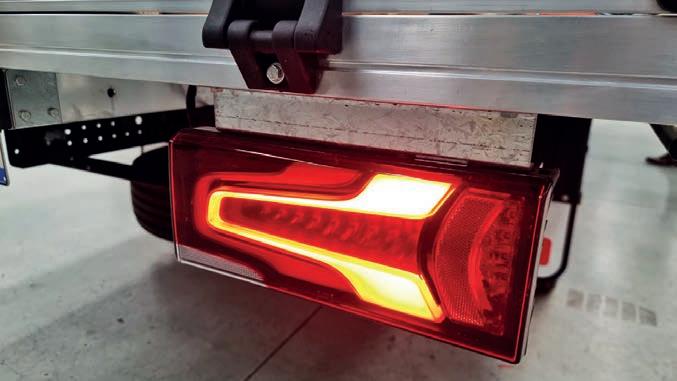
When you think about the tonnage on the back of this truck, and in fact what the truck itself weighs, its acceleration is exhilarating, not in the usual sense of revving, changing gears and so forth, but rather in a beautifully linear progression and build-up of speed.
It’s quick, and whilst this time around I couldn’t manage any tra c light escapades,
I did a standing start against, as it happened, an identical Fuso Diesel – and left it in my wake. Oh, and the eCanter is quiet.
Of course it would be with no diesel thumping away. Unless you’ve driven a truck such as this you simply have no idea how that constant noise adds to your fatigue at day’s end. e di erence is truly startling.
A tra c light changes to yellow. Not enough time to stop so I power through it. In an ICE truck it would have turned red and I’d have copped three points on my licence. Another light goes to yellow and this time I stamp on the brakes with no time to think of icking the regen lever forward. e disc brakes work just ne on those occasions where you really need them. I spend half a day in the Wide Cab and the other half in the City Cab and they are both brilliant. e air-con was on full blast all day as I wafted in and out of tra c, surged down motorways and forgot all about looking at how much charge was left.
At the end there was plenty. I’ve done what any lastmile delivery driver would do, the di erence being that I didn’t feel at all taxed in body or mind.
ese trucks are premium in every sense of the wordnot bad for a delivery vehicle. Electric? Don’t knock it until you’ve tried it.
Carrying on a restoration tradition started by his father, this long-time operator hits the road again with his rolling tribute to a bygone era.
BY DAVID VILE“I DID 50 years in trucks. I’m not one to be playing lawn bowls or anything like that so while you can do it, you might as well be out there.”
And being ‘out there’ is something that Chris ‘Squeeka’ Overend does from behind the wheel of his 1989 Mack Value-Liner, loaded up with two lovingly restored 1965 B-Model Macks.
Chris, from Barinsdale in Victoria, was on an extended road trip, taking in a number of truck shows in both Victoria and New South Wales.
With one of his stops taking in the Lockhart Truck Show in early March, the three Macks on display were popular with visitors and all having their own story to tell.
Overend Transport was a well-known operation working out of Gippsland for a number of years, with the late Bert Overend (Chris’s father), running a mixed eet of trucks including Macks and Internationals hauling all manner of freight.
With Bert wanting to restore a truck, Chris tracked a B-61 down in Dalby in Queensland. Bert took on the project at the age of 79, completing it in under 12 months. e truck today serves as a tribute, presented today in the same state as when Bert nished the overhaul.
“I have hardly touched it, that’s how he had it when he nished the restoration on it, all I have done is put the stainless guards on it,” Chris said.
Carrying on the tradition, Chris was also on the lookout for another ‘B’ model to restore, which led to the B-75 nding its way into a shipping container from New York to Melbourne, with the deal being done through Ian Lee of Kyneton.
“ e B-75 was totally different to anything else I had seen with the longer bonnet and so forth – the ’70’ series is a beautiful shape; they are a beautiful looking truck. I bought it o Ian Lee when it was still in the United States, and it took about six months to arrive.
Apparently, it had been towing a tipper around New York City - we took it all apart and it took about ve years to get it all back together,” he explained.
e B-75 was taken back to the rails and given its quite short wheelbase and longer bonnet, the chassis was extended.
e B-75 was tted with an extra exhaust and air cleaner and resprayed in ‘Heritage Red’ which is a Ford factory paint code with Gordon McCracken doing
THE B-75 WAS TOTALLY DIFFERENT TO ANYTHING ELSE I HAD SEEN WITH THE LONGER BONNET AND SO FORTH – THE ’70’ SERIES IS A BEAUTIFUL SHAPE; THEY ARE A
BEAUTIFUL LOOKING TRUCK.”
CHRIS OVEREND
the signwriting and scrollwork.
While both the B-61 and the B-75 share the same engine and di s that’s where the similarities end - the B-61 runs a quad box and a ‘traditional’ air starter whereas the B-75 has a duplex transmission and an electric start.
“ ey only made around 1300 B-75’s all up so that’s why I have left it in Lefthand drive con guration. It was pretty sad and sorry when we got it, it was frustrating at times rebuilding it but very rewarding to look at it now,” Chris said.
With the two ‘65 Macks in the stable Chris was in need of something with which to haul them around the place, with his next purchase a 1989 V8 Mack Value Liner which had been initially built for IPEC and painted in their bright yellow eet colours.

As Chris explained: “ e IPEC order was originally for 13 trucks which they built, they had two of these on trial but Scania won the contract so there were a few of these sitting around. It has ‘fast’ di s in it, so it is a bloody quick truck.”
e Value-Liner went through the hands of a number of owner-drivers, clocking up around 1.5 million kilometres before Chris purchased it from Pat Martin in Brisbane.
At time the motor had a crack through the block, necessitating a major rebuild for the E9-V8.
“We got a new block and all the good bits out of the old motor, spent over $50,000 on it and got it back on the road around 2014, ready for the Alice Springs reunion in 2015,” he said.
Fast forward to 2024 and Chris’s rolling truck show is still clocking the kilometres up and having looked at the calendar, the opportunity to take in a number of stops had Chris loading up and hitting the road.
“I thought we could make a good trip out of this - we went to Lardner Park and Lance eld, up here to Lockhart and will go down to Clunes, back to Kyabram for the Mack Muster and then home, thinking we will be away for around ve

weeks all up,” he said. Having just completed a restoration of an International R190 for a mate, Chris can now turn his attention to the next project, a 1960s ‘Seattle’ Kenworth,
think about transporting it around in
“I will head home and make a start on that….but I might have to go and get myself an ‘A’ trailer to hook on so I can cart it around as well,” he said with a grin.
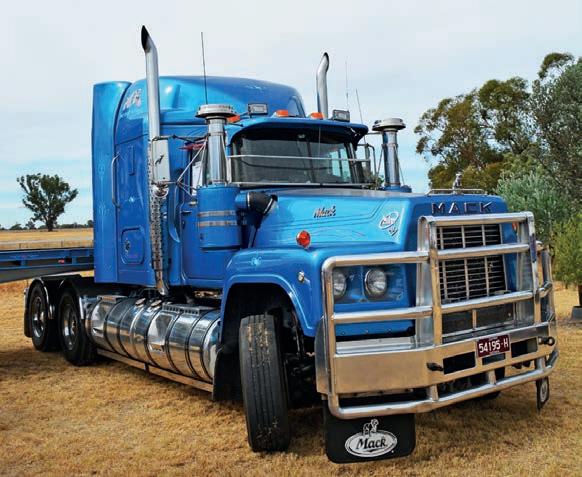

Knowing how much his two-year-old little girl loves his truck, secondgeneration truckie Nathan Pearce made Riley a miniature version of her own.BY DANIELLE GULLACI
THE son of a truck driver, Nathan Pearce, 43, says he grew up in and around trucks. And now he’s passing that same passion onto his young daughter Riley, who at just two years of age is “absolutely truck mad.”
As Pearce revealed, “She loves my truck, every time she sees it, she’s more excited to see the truck than she is to see me!” And that’s how he came up with an idea for the perfect Christmas gift for Riley.
Based in Townsville, but originally from Gympie on the Sunshine Coast, Pearce has been driving trucks for over 20 years. He’s been with Followmont’s Townsville team for over 18 months, carrying refrigerated goods from Innisfail to Brisbane, Sydney and Melbourne from behind the wheel of a 2023 model Kenworth K200 – and Riley’s quite the fan.
“When I go away with the truck, my partner and Riley will drop me o at the depot so I don’t need to leave my car there and Riley will come into the yard to take a little ride in the truck – or if I take it home to give it a wash, she’s up in the cabin straight away,” said Pearce.
“Dad was a truck driver for as long as I can remember. I’ve grown up around trucks my entire life. But I wanted to do truck driving o my own bat, so at 19 I went and got my truck licence. I’ve done a bit of everything: side tippers, oat work, general freight, oversize, pipeline stu , water tankers. e only thing I haven’t done
SHE LOVES MY TRUCK, EVERY TIME SHE SEES IT, SHE’S MORE EXCITED TO SEE THE TRUCK THAN SHE IS TO

really is livestock.” Last Christmas, Pearce planned to spend Christmas day with family at his parents house in Gympie, so Followmont gave him a load down to Brisbane, so they could all be together for the occasion.
He picked up Riley’s jazzed up little truck from the depot and headed over to surprise her. e toy truck was actually a blue remote-controlled Mercedes-Benz Actros rideon, which Pearce’s mother had found on Facebook Marketplace. “I painted it all up to look like mine and put the stickers on it, and made the unit number the same as mine too,” Pearce said. “When I brought the little truck home,
hype it’s got. I just knew how much she loved mine so wanted to make her a copy of daddy’s truck.
“When I got a phone call from the o ce saying Big Rigs wants to interview me about my famous little truck, I couldn’t believe it,” laughed Pearce.
“When I made it, all I wanted to do was make a little truck for my little girl.
“ e truck didn’t have the remote with it when I bought it because it was lost, so when I found out you could buy them, I got one for her because she’s still too little to drive it on her own with the pedals.”

When Pearce arrived at his parents, it took a minute for Riley to realise she had a new ride. “She saw my truck and was so excited. All she could see was my truck at that point,
so she made a bee line to it –and then I asked, ‘Well if this is daddy’s truck, whose is this truck?’ Straight away she said, ‘Riley’s truck!’
“She was chasing it around the yard and didn’t want to get into it at rst, but then once she was in, we couldn’t get her out of it.
“Every time someone came to mum and dad’s place over the Christmas break while we there, she took them straight out to see her truck. She abso lutely loves it.”
Now that Riley’s little truck is complete, Pearce is planning on making it even better. “You can actually get little trailers for it too – they’re out of stock at the moment, so I’m waiting for them to come in. It’s a little at top trailer, but I’ll make it into a fridge van so it looks just like mine.”

could. “My middle daughter could name every type of truck con guration when she was ve or six, but as she got older, she got away from it. I’d like

to think Riley might stick with it,” he said.
Being an interstate truck driver, the nights away from his little girl can be tough, but as Pearce revealed, “Knowing you’re coming home to that de nitely makes the long nights away more bearable.”




Built





SHELL Rimula has partnered with Big Rigs in a big way – so there’s even more reasons to send in your best truck shots.
Each month, the Big Rigs team will choose a #PicOfTheMonth, with the lucky winner receiving a $500 Shell Coles Express Gift Card.
Keep an eye out for our regular posts on the Big Rigs National Road Transport Newspaper Facebook page, calling
for your best truck photos and add yours in the comments, or email them to kayla.walsh@ primecreative.com.au.
Don’t forget to include a brief note about the truck and where the photo was taken. We’ll feature some of the best photos in each edition of Big Rigs Newspaper, with one winner announced each month. Keep those amazing truck pics coming!
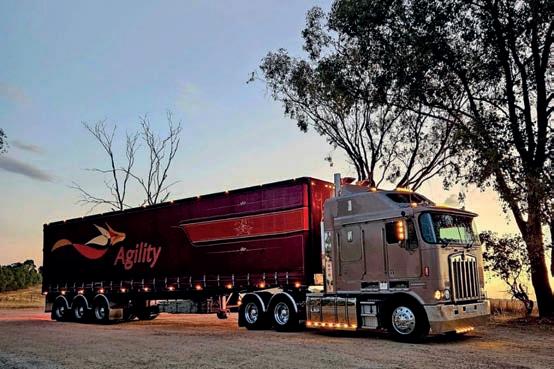




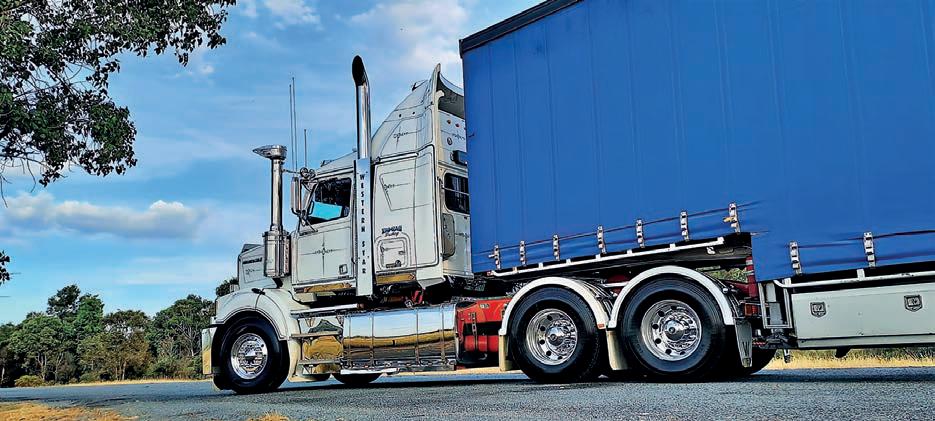
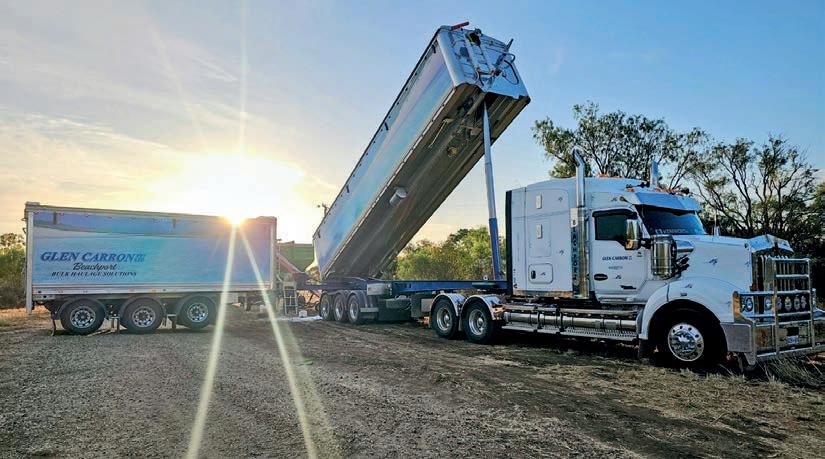
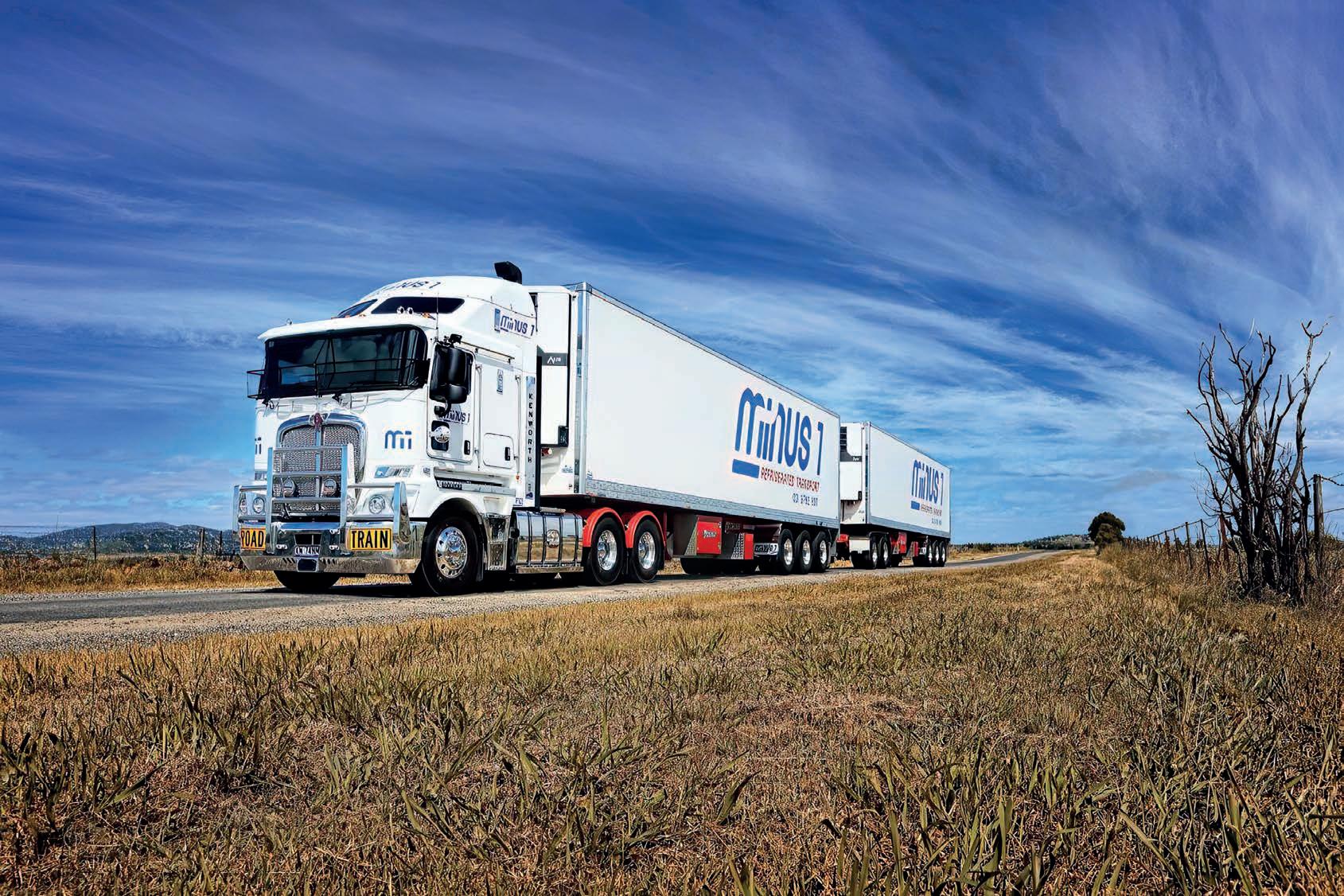







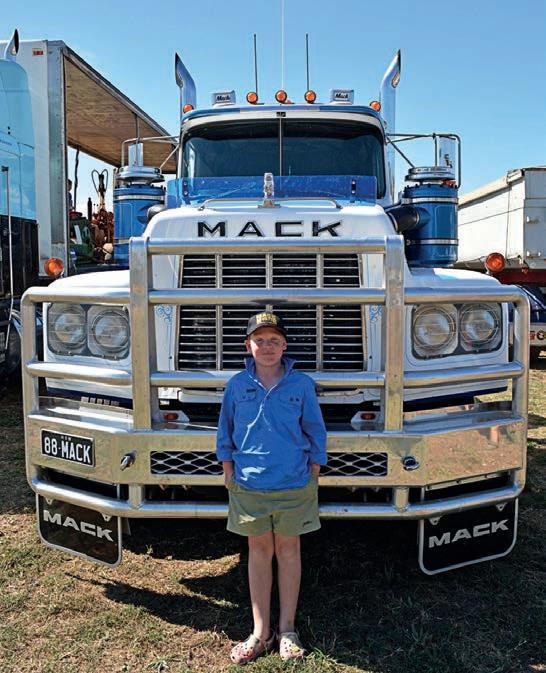


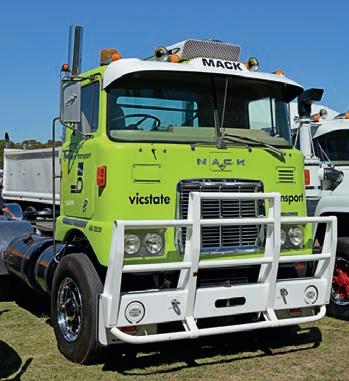



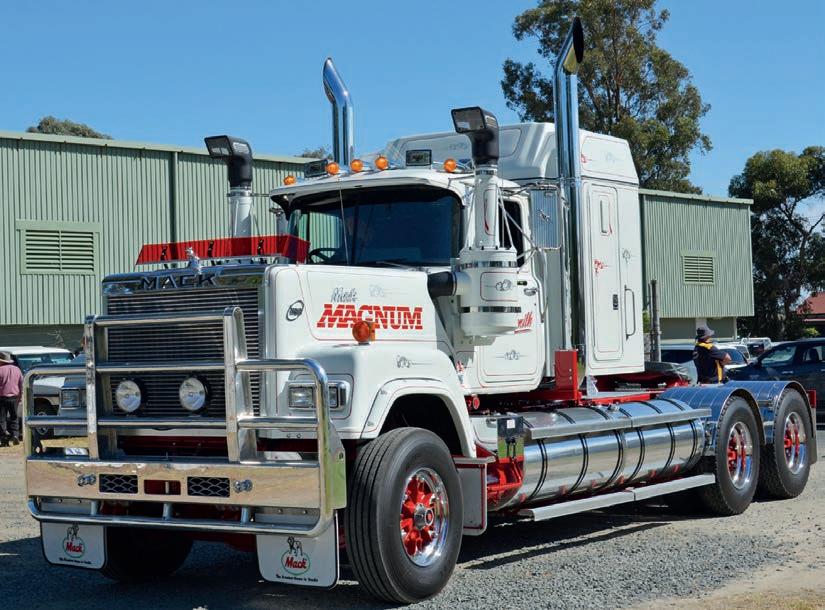 BY DAVID VILE
BY DAVID VILE
FOR those faithful to the Bulldog breed, there was only one place to be across the weekend of March 16-17 as over 160 Macks of all models, sizes and shapes descended on the Goulburn Valley town of Kyabram for the 2024 Mack Muster.
Scheduled as a biennial event, the Muster was making a comeback this year having essentially had a six-year hiatus with Covid seeing the cancellation of the 2020 and 2022 events.
Virtually every model from the Mack kennel was represented across the weekend, from the famous B-Model variants and F-Model cabovers through to the R-Models, Value-Liners and the Super-Liner which has been a mainstay of the Mack product line for over 40 years.
Dave Willis, from the

With all brands welcome, there was a great variety of trucks on display.
organising committee, was thrilled with the turnout of trucks which came from as far a eld as Tasmania, Queensland and South Australia.
“It was a little hard to gauge how things were going to pan out with numbers, but we are delighted with the roll up –currently we are looking at about 167 Macks registered, which beats our previous record – it’s a great result.
We have got everything here from the latest 2024 Super-Liner right back to the rare 1923 AC model so there’s 100
years of trucking there. All of these trucks have their own story to tell.” e event also included a Muster dinner with 165 attendees and presentations from former Mack employees – Russell Simpson and Dennis Taylor – who travelled down from Brisbane. With the event held in rotation with the White Truck Muster at the same venue, the Mack Muster committee will be looking at making the next get-together in 2026 another great spectacle.
 BY KAYLA WALSH
BY KAYLA WALSH
THE organisers of the Oaklands Truck Show in NSW were delighted to see a record number of rigs at the annual event on March 16-17, with sunny weather helping to attract a great crowd.
ere was fun for all the family, with kids’ activities, live music, market stalls, food and more.
Presentations to car, ute and bike owners were made on Saturday, before the focus turned to the real stars: trucks.
ere were plenty of shiny rigs on display, but it was JDN Transport who took out the big prize –Truck of the Show – with their Kenworth T909 2019.
Meanwhile Glen Kearney
worths, brought home Best Fleet and Best 0-2 Years.
e president of the show’s committee, Jimmy Beale, told Big Rigs that the weekend was a “great success”.
“Everyone had a ball,” he said. “ ere was great weather and a great atmosphere. We were really happy with how it all went.”
As the sun set on Sunday, the mood became more sombre as rigs lined up for Lights on the Hill.
“Lights on the Hill was a real highlight,” said Beale.
“It’s in memory of a young bloke who died, Wayne Martin.”
is year the Oaklands Truck Show Committee also unveiled their new Wall of Fame, adding local truckie Max Dickens.


Schifferle Freight Services joined in the fun. Image: Strathmerton Truck Spotting
for 20 years,” Beale said. “He’s driven for four or ve di erent companies in tankers, and he was nominated for Driver of the Year with Shell one year.”
e committee are planning an o cial launch of the wall later this year, and anyone who would like to nominate someone they know can get in touch with Beale on 0428 570 325 or email oaklandsts@hotmail.com.

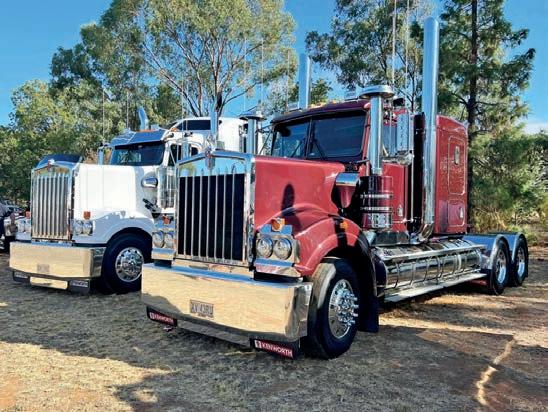

Best
Best 9-14 Years
Best 15-20 Years
Best 21-26 Years
Best Vintage 27+ Years
Best Artistic

T909 2018 – Lieschke Transport
T909 2011 – Grays Transport
T404 2004 – Adrian Tyndall
T900 1998 – Willett Transport
281 1967 – McSweeney Transport
t659 2024 – Willett Transport
Best Dirty Truck Mack Superliner 2022 – Kreskas Bros
Best Local Kenworth W900 2022 – Beale Transport
Best Fleet Kearney Transport
Whealan
Tyndall
Willett
Best Farm Mack Superliner 1987 – Madness Robert Trethowan
Committee’s Choice Kenworth SAR 2023 – PC Freight
Runner up – Lights on the Hill Kenworth SAR 2023 – PC Freight
David Frew
David Frew

Kenworth W900 SAR 1986
Darryl Stelter
Kenworth T900 1998 – Willett Transport Scott Willett
Kenworth T909 2019 – JDN Transport
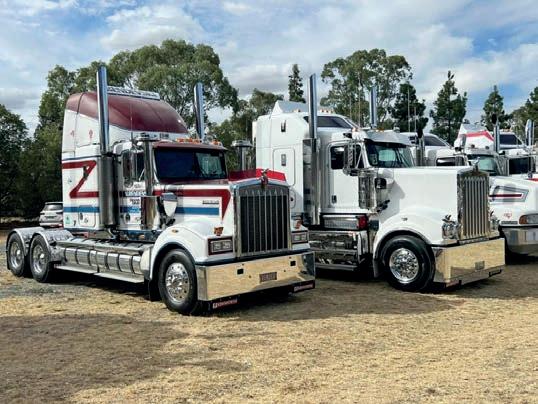
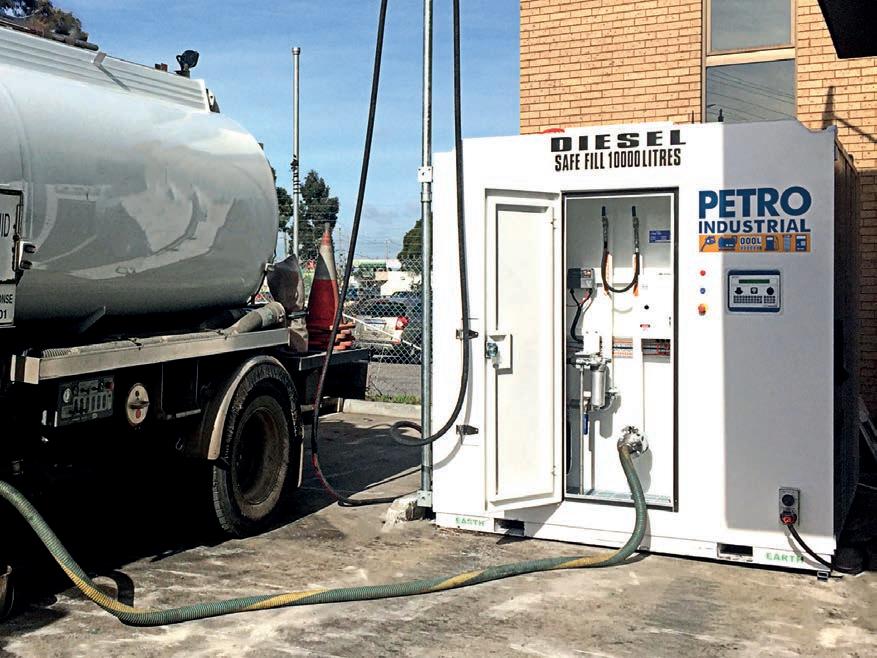
PETRO Industrial, a distinguished player in the fuel and lubrication storage and dispensing solutions industry, has been revolutionising the landscape with its tailored, turnkey storage solutions.
From compact ‘back on a ute tanks’ to expansive projects in road and air transport, agriculture and mining, our in-house teams manage every aspect, providing a comprehensive and seamless one-stopshop experience.
Our success lies in the synergy of our experienced engineering and design team, well-acquainted with the nuances of the industry, and our manufacturing team that delivers top-tier commercial refuelling equipment. is integrated approach ensures that we not only meet but exceed the expectations of our diverse clientele.
At the forefront of our o erings is iPETRO, a cutting-edge uid management and track-

ing solution that sets us apart in today’s dynamic business environment. iPETRO is a range of cloud based electronic uid management products that provides full control of all liquid dispensed. E ective accountability for your fuel stock is essential to running a welloiled business. iPETRO records and stores all data on the iPETRO Cloud website in real time and can be accessed 24/7.
Whether seamlessly integrating into existing fuel equipment or utilising the iPETRO Pro and Lite FMS product range for management and online cloud data storage, iPETRO ensures meticulous monitoring of every litre dispensed. is level of precision is a game-changer for businesses seeking optimal control over their fuel management.
What makes iPETRO truly exceptional is its iPETRO Vendor Management Dashboard (VMI), a feature that consolidates data from multiple sites onto one uni ed platform.
e geographical location of your sites becomes irrelevant as iPETRO brings all the critical data together, o ering a comprehensive overview of your operations. is centralised approach enhances decision-making, facilitates streamlined processes, and ultimately contributes to operational eciency.
Moreover, iPETRO goes beyond conventional uid management solutions by incorporating telematics and link tank gauging with our newest addition iPETRO Link. is innovative product enables the seamless linking of equipment from various manufacturers such as Ocio, Piusi, Ole and many others, providing businesses with unparalleled ex-
ibility and control over their fuel management systems. iPETRO, in essence, becomes the nerve centre that connects and optimises disparate elements within a fuelling infrastructure. e signi cance of iPETRO in today’s business landscape cannot be overstated. As businesses evolve and embrace technological advancements, iPETRO stands as a testament to the power of innovation in fuel management. It not only addresses the immediate needs of tracking and monitoring fuel dispensing but also anticipates future requirements by integrating telematics and o ering a holistic approach to vendor management.
PETRO boasts diversity within the business by supplying to some of the most remote areas in Australia, and the international markets. Our satis ed customers are spread throughout multiple industries including mining, educational, road transport, power generation, fuel distribution, construction, marine and aviation. Proudly Australian owned and operated, we aim to enhance the Australian industries.
Our friendly team is on standby to help with all your future bulk fuel storage and dispensing needs.

PACCAR Parts has launched its new premium, Australian made coolant: TRP ALLCOOL.
Developed to help protect engines from both overheating and freezing, ALLCOOL works to keep your truck on the road every single day, come rain or shine.
PACCAR Parts product manager eresa Weymouth said TRP ALLCOOL was originally developed as a factory ll coolant and when properly maintained meets and exceeds many OEM (original equipment manufacturers) requirements.
“Some of the main bene ts of TRP ALLCOOL include protecting diesel engines from liner pitting and scale deposits as well as preventing corrosion of metal components in the cooling system,” Weymouth said.
Available in both pre-
mixed and concentrate formulas and in a range of sizes, TRP ALLCOOL is a universal ethylene gly col anti‐freeze and anti‐boil coolant which uses an advanced fully for mulated inhibitor pack age to provide superior protection against liner pitting and scale depos its. e low silicate for mula protects all cooling system metals, including aluminium, from corro sion.
TRP ALLCOOL meets and exceeds ASTM speci cations for both heavy duty and au tomotive applications.

TRP provides a reliable range of quality, warranty-backed parts and products for all makes of trucks and trailers.
To back its commitment to supplying reliable and proven products, TRP put its parts through rigorous testing to ensure they meet or exceed industry standards. Its parts and products are available at its dedicated TRP Stores and PACCAR Parts dealerships Australia-wide.
To nd out more about the TRP range of quality products and services, or to nd your closest stockist, please visit trpparts. com.au.
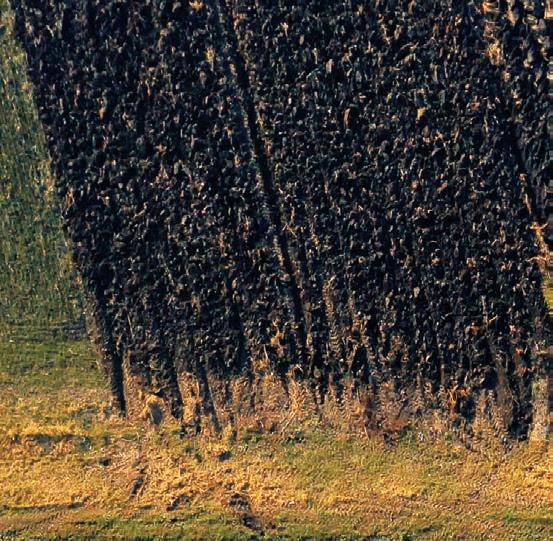




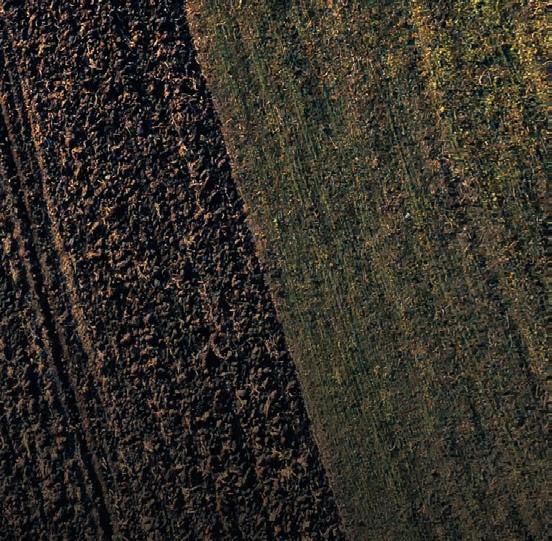





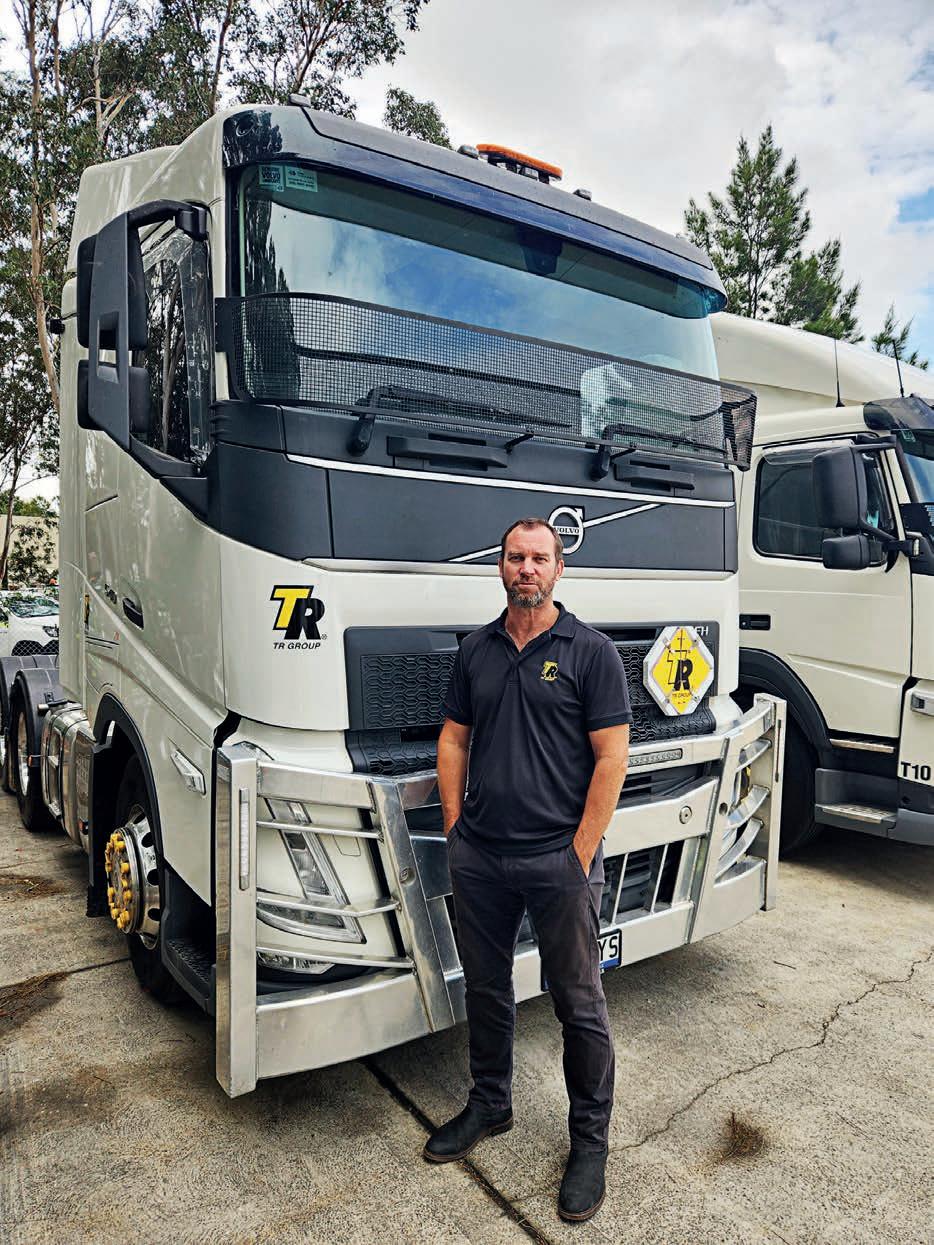
OPERATING a huge national eet, truck and trailer rental and lease business TR Group is using smart technology to help manage its assets and ensure compliance.
TR Group rst came onto the Australian scene ve years ago, with just one branch. rough phenomenal growth it now operates across locations at Adelaide, Brisbane, Melbourne, Sydney, Newcastle and Perth, with a rental eet of over 2500 assets, including over 500 prime movers and rigids.
Its extensive trailer o ering covers everything from skels to A-doubles, side loaders, fridge bodies, Performance-Based Standards (PBS) combinations, WA road train side tippers and more.
It was about three years ago that TR Group began implementing systems from WHG. is started with the use of asset management software in the form of WHG’s solar tracking technology which has been implemented across the en-
tire trailer eet, along with many of their trucks.

WHG’s solar tracking trailer solution. Image: WHG
Fast forward to now, and TR Group is using a full suite of technology from WHG including telematics, the company’s Smart On-Board mass (OBM) system called FleetWEIGH, which was launched late last year, a customised QR code system and WHG’s software platform.
As national eet and
maintenance manager Rian Alexander explained, the business was looking for much more than just a software and equipment supplier.
“As a business, we want to work with a business that isn’t just a supplier. We want to be able to grow together with a partnership and relationship. WHG has been good like that.
ey’ve become an important asset to the business as we continue to move forward. And of course, customer service and back-up support is key.
“ e biggest thing that we keep pushing is that this working relationship is a partnership. ere’s no ‘you’ and ‘us’.” He added that for TR Group, tracking is vital –and for more reasons than you’d think. “For us, tracking is a must. You do need to know the location of an asset when it’s a rental, as you do have cases where it can be dropped where it’s not meant to be,” said Alexander.
“But knowing where the
asset is and how many kilometres it has done also means we know when and where it needs to be serviced – and servicing our equipment is key to our business.”
“For example, although an asset might be rented out of our Melbourne branch, it could be heading into Cairns when it’s due for a service, so that means we can get one of our service providers to get it in and get it done.”
“Having access to an asset’s real life location and kilometres is key to ensuring you can service things on time. e reason we take time and kilometres into consideration is because for example, some of our assets only run in circles o a wharf. ey don’t do high kilometres but they do high time, so the platform WHG has customised for us looks at both time and kilometres to see which is due.”
Alexander continued, “One of the added values we provide to our customers is that we look after the maintenance in-house. We create our own service plans for our assets to ensure we meet not only the OEM requirements but our requirements as well – so we inspect our equipment on a more frequent level.”
As TR Group has found, implementing QR codes onto all of the trailers is further assisting with this requirement.
Trailers account for a signi cant chunk of the TR Group eet. With a quick and easy scan, technicians and managers have access to all of the data for that particular asset. Given that TR Group operates at scale, this has helped to bolster productivity and e ciency – reducing the amount of paperwork.

FleetWEIGH is a telematics and Smart
system is further developed, so it’s been a work in progress and one that we’ve worked on together with WHG,” said Alexander.
More recently, the addition of WHG’s FleetWEIGH technology has taken things another step further.
A Smart OBM solution for suspension trucks and trailers, FleetWEIGH is a ground-breaking mass management system that is easy to install, with reliable Bluetooth and weight sensor technology for seamless integration with real time in-cabin visibility, plus remote monitoring by back o ce teams.

ese QR codes are now being used for pre-starts, safety checks and basic operation guides. “ e QR codes have been on our trailers for a while as the
FleetWEIGH is the rst TCA certi ed Smart OBM system with embedded telematics monitoring for use in conjunction with the Telematics Monitoring Application, eliminating the need for multiple systems and needing to manage multiple suppliers. ough as a rental and lease business, Alexander admits that OBM wasn’t always high on the agenda for TR Group. “It wasn’t a massive part of our processes but it is now. A lot of customers are requiring smart OBM as their businesses have grown and we want to be able to grow with them. We had tried a competitor’s product. But it’s all about the right product, the right service and the right relationship,” he said – and it’s clear to see that WHG delivers that in spades.
“FleetWEIGH works very well. It’s simple to in-
stall, it doesn’t require a lot of wiring, and it’s remote wireless through to the tablet in the cab which is locked into position, so it can’t be removed by anybody.”
For TR Group, WHG really has been able to deliver the full package: a great product, great service and the ability to deliver customised solutions that match the company’s needs.
“One of the key reasons we’ve been with WHG for this period of time is that their support is second to none. If I pick up the phone and have a requirement, it’s addressed then and there. ey go above and beyond if we have any issues and are always willing to discuss our needs, and what we can do better and do together,” said Alexander.
“Together we’ll keep growing and looking at di erent opportunities and challenges, developing new ideas together, instead of as individuals.”
TR Group make Truck and Trailer rental and lease easy for you. Pre- tted with WHG’s telematics and Smart On-Board Mass, your rig is ready to hit the open road.
TR Group is a specialist heavy commercial truck and trailer rental and lease supplier. Call TR Group on 1800 50 40 50. Contact WHG Solutions today to nd the right solution for your eet. Call 1800 474 387 or visit whg-telematics.com.

TIME means money for those specialising in hotshot transport and urgent freight, and when Western Australian based Harmon Transportation needed to implement a eet management system – fast – they




found the answer with TMFleet.
Harmon Transportation required a system that not only allowed them to oversee and manage their mixed eet of assets including utes and trucks, but more im-
portantly they wanted to ensure the new system was easy to use and quick to adopt.
“We required a system that would remove the need for spreadsheets and allow us to see a snapshot of the eet,” said Harmon Transportation’s general manager Paul Konstek.
“Another important factor was ensuring that any sta member could take over eet management without complex training, and TMFleet has provided this and more.”
Whilst it all sounds fairly straightforward, it’s a challenging task to nd software that not only appears simple but is also easy enough for anyone to login and use, yet TMFleet seems to have nailed the task.
Management are presented with a dashboard that highlights upcoming servicing and renewals like registration or re extinguisher tagging, thus reducing the risk of missing important recurring tasks.
e dashboard also highlights repair requests that have come through from
the driver, either manually, or that have been automatically generated from a failed pre-start question.
e true backbone of TMFleet is the digital prestarts that drivers complete on their mobile phone before they jump in a truck, vehicle, or machine. Every time a driver completes a pre-start, not only are they ensuring the safety and compliance of the vehicle, but without realising they’re also completing administrative tasks that the operations team would otherwise have to chase up and complete.
“TMFleet has automated a bunch of tasks for drivers and eet managers, even basic things like updating kilometres in the backend of the system so that scheduled services aren’t missed, or automatically creating a repair request from a failed pre-start,” stated Kathy Smith, business development manager at TMFleet.
“Our team really took the time to break down what was missing in the market to ensure that we’re able to o er a solution

that truly makes the safety, maintenance and management of a eet easier.”
e digital pre-starts can be fully customised at no additional cost, and it’s one of the few systems available where it’s easy enough for an admin user to jump in themselves and edit or create their own customised solutions.
Konstek added, “We used to rely on paper, so if there was a failure in any area, it was a complex process where the driver would have to call the operations manager to discuss the issue. Now, with the ability to set the severity of the problem within the pre-start, the driver knows whether that
vehicle can leave the depot.
“We also receive the prestarts in real time instead of waiting for the driver to return to base, so if we’re required to order a part for a minor issue, we can now do this immediately and resolve the problem as soon as the vehicle returns.”
TMFleet caters for eets of all sizes, even o ering their system for free to businesses with eets with less than 10 assets. Keeping with the theme of simplicity, TMFleet has kept their pricing model simple with no setup fees and a at monthly cost based on the number of assets you have. Visit tm eet.com.au for more information.




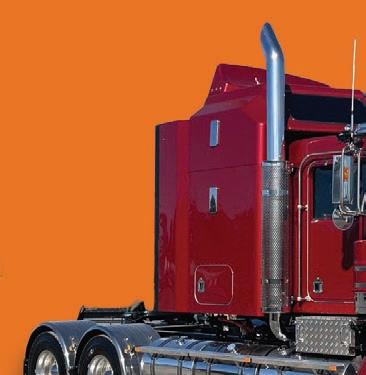





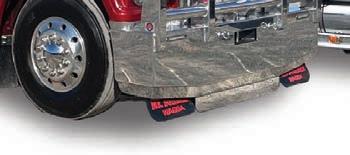


VIDEO telematics is a game-changer for eet managers – here’s what you need to know.
When you think of articial intelligence, something like ChatGPT comes to mind, a chatbot with useful tips on planning a child’s birthday party, a summary of a long article, or great places to eat while on holiday.
It’s important to know, however, that AI is so much more than just a chatbot. e latest AI-powered dashcams show how machine learning has real bene ts for transport businesses, and in particular, eet managers. Yet, even without AI, dashcams and video telematics are powerful tools for understanding your driver’s performance and helping with coaching. AI supercharges them.
How does video telematics work?
Traditionally, telematics devices have been ‘black boxes’ that are hardwired devices installed within vehicles. ey log everything from location information right through to vehicle performance and driver behaviour through metrics like harsh braking and manoeuvring and provide details on fuel use, idle, and more. With advancements in today’s technology, your tra-
ditional dashcams have gotten smarter, by integrating telematics alongside the cameras to capture footage alongside vehicle and driver metrics. As events are triggered, you get an even bigger picture of the operation.
Often available in high-de nition, the footage is instantly uploaded from the cloud to a eet management platform, like Teletrac Navman’s TN360 system.
is is where those in the back o ce can view all the eet’s location, insights, and analytics, including the alerts that are raised for events that occur on the road.
With video telematics, eet managers can view footage alongside all the data generated, meaning they can see the real story and protect their drivers. ere’s no waiting for a truck to come back to base to download footage; the business can help to ensure the safety and e ciency of the vehicles on the road, meaning drivers get home safely at night.

So, where do you get started? Several key items to look for in a video telematics solution include the ability to record all drive-time and retain footage for driving events recorded by the telematics system that can be viewed from the eet management system.


Fully
Ensuring that the system itself is integrated into the overall eet management solution is important. is ensures that your eet managers have one platform to see everything, saving time in tracking down information, and seeing the complete picture instantly, helping make decisions quicker.
Where AI comes into play
What if it was possible to automate the process of reviewing footage, where data is analysed carefully for you, and you receive alerts when an event needs attention? at’s
where AI steps in. An AI-powered dashcam supercharges the already powerful eet management and safety capabilities of regular dashcams by turning the camera into a third eye. Computer vision technology lets the camera constantly review all the drive-time footage as it happens, automatically identifying both positive behaviours and dangerous actions. Not only does it warn the driver, but it provides valuable insights into the eet previously unobtainable, even with traditional telematics.
ese dangerous actions

into TN360, our diverse range of cameras deliver you real-time footage and data to help you improve safety, streamline coaching and protect drivers.
Now that’s choice.
include distracted driving, mobile phone use, tailgating, harsh manoeuvring and braking, if the driver exceeds the posted speed limit, illegal U-turns, driver distractions, and more.
Video telematics can record all these actions in the telematics software, which are available to view at any time.
e cameras also include real-time verbal feedback, letting the driver immediately know if they’re doing something dangerous – they may be taking o too quickly o a red light, cornering too hard or, more importantly, getting distracted or showing signs of fatigue.
Teletrac Navman’s TS24 report found that 47 per cent of eet managers are currently using AI solutions in their eets, a number likely to grow as more managers realise the bene ts of machines and humans working together for better safety and e ciency outcomes.
Adding a video telematics solution to your eet management toolkit has many bene ts, including improved driver safety and driver retention. Drivers will want to work for companies that value safety and recognise driv-


1300 111 477



ing talent, something a video telematics solution provides. Recognition and rewards programs based on transparent video footage are key weapons in a eet manager’s arsenal for keeping good drivers on board.
A video solution will also help an organisation win new business by demonstrating a commitment to safety and investment in driver wellbeing. Both factors o er a compelling di erentiator when bidding for new contracts.
It will also lead to cost savings through better driver behaviour, leading to lower fuel and maintenance outgoings.
In fact, Teletrac Navman customer Jarratt Transport Solutions, based in the Port of Brisbane, Queensland, estimates an integrated telematics solution saves it around 3000 litres of fuel per month.
e company also uses driver scoreboards, with the top driver earning a bonus of $500 each month, a cost the company states is ‘a drop in the ocean’ compared to its overall savings on fuel and maintenance through better driver behaviour.
Video is the logical next step for eets already invested in a telematics solution. Keen to learn more? Talk to your Teletrac Navman representative today.



Roadhouse parking space concerns
Finding a parking space for heavy vehicles at many roadhouses is a big problem for drivers.
Especially with the penalties drivers face if they are deemed to have broken strict fatigue laws.
One area of concern is at some roadhouses off the Newell Highway in NSW.
“You get there on what is a scheduled fatigue break time and find that there are no parking spaces. Often there are road trains, B-doubles and even triples there,” one driver said.
Another driver agreed with that and said it ensured he had to move on to find another place to park.
“That can often put you in breach of the laws and where do we go?” he said.
He pointed out there were distance and time monitoring cameras in place.
Yet another said some of the roadhouses along that route were built in the 1970s when there were a lot less heavy vehicles.
“They were mostly singles then and they haven’t been
So, when scores of them offered praise for part of the notorious Bruce, Spy just had to check it out.
This was the 80km stretch between the outskirts of Townsville and to just north of Ayr in the Burdekin region.
There has been heaps of roadworks completed there in recent times and I drove it twice in early March.
It certainly is a lot safer than it used to be and was a pleasure to negotiate.
If there was one small criticism it was about the many pull off areas which have popped up beside the road.
Most of these are very narrow with not much space between the exterior of a truck and traffic travelling past.
The 100km section of the Home Hill to Bowen section has also improved after roadworks but is still rough in places.
Tasmanian rest area
There seems to be a genuine shortage of rest areas in Tasmania where truck drivers can stop for a fatigue break.
However, with generally short distances between centres when compared to the mainland it is not totally surprising.
One good one I found when in Tassie was off the Midlands Highway at St Peters Pass.
with Alf Wilson Spy on the Road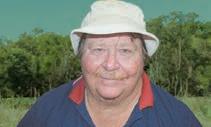

Located 107km south of Launceston and 91km north of Hobart it has clean toilets and is right beside the highway.
It is used by many motorists including caravanners and there is some parking for trucks to the side but with no turning section. Few heavy vehicles can fit into the normal parking section.
Along the Midlands there are plenty of roadhouses.
No mangoes
Spy recently stopped in at the Giru United Roadhouse on the Bruce Highway. The renovated building is really good and the food was excellent.
But something was missing from when it was called the Greenacres Roadhouse for decades.
Truckies who stopped there will fondly recall the toilets which around one side had “mangoes” and “no mangoes” signs on the doors.

Wide load
Spy was sent pictures of a massive wide load which had been travelling along the Leichhardt Highway south of Dululu.
They were a witty way of advising users which were the male and female dunnies in an area where lots of mangoes are grown.
Dululu is a small rural town located in the Shire of Banana. It is situated at the junction of two major highways, the Burnett and Leichhardt. Additionally, at the rest area in Dululu, you’ll find a plaque honoring early settlers who played a significant role.

Nearby is a rest area although it is mostly full of caravans. The person who snapped the pics had pulled over to enable the wide load to pass.
I always appreciate when readers or friends send in such pics.
Life-changing liver transplant
I was sitting in a cafe last week frequented by truckies and had a conversation with a well known transport man now aged in his sixties. He told of being an alcoholic for many years and came home one day back in 2012 to find his long-time wife had left him and the house they owned had been cleared of most furniture. His neighbours had even taken pictures of the utes taking the furniture away whilst he was not there.
“I would drink about 15 beers a day and my health was bad. I had been charged with drink driving eight times and the magistrate on the last occasion warned me to bring my toothbrush next time it happened as I would be going to jail. It was my last chance,” he said.
The man was rushed to hospital and was told his liver was functioning at around 5 per cent and he would die if he didn’t have a transplant.


Luckily a donor was found and the transplant was successful. He is now in much better health.
“I haven’t had a drink of alcohol in years and live a much better life,” he said.
The man now has a good job as a road traffic control worker has come into contact with many truckies on a daily basis.
It was a touching story and I wished him well.
Wet roads in WA
Heavy rain in parts of WA
around Mt Tom Price forced temporary closures of dirt roads.
“The roads are well maintained but can’t be graded after a lot of rain and have to be closed,” one Perth based driver said.
That was a similar case with dirt roads around Laverton in WA.
Even in dry times truckies are wary whilst negotiating their way to Laverton.
“The road is graded with underground water which has lots of salt in it. Even af-
ter it dries you can see salt left on the surface. So we are careful getting along it,” one said.
Crocodile tours in NT
Spy hears that a group of retired truck drivers from South Australia, Victoria and NSW will embark on a tour of the Northern Territory which will include a visit to the iconic Humpty Doo Hotel.
The driver of their bus will be a former truckie with lots of years of service in the NT
 with Alf Wilson
with Alf Wilson

and SA.
Humpty Doo Hotel is about 40km from Darwin and situated just south of the Arnhem Highway.
It is also 85km from Litchfield National Park and the gateway to Kakadu National Park.
“We want to stop for a long visit at the Humpty Doo Hotel where many of us went to and enjoyed it when we drove trucks around there. Most will be sucking into a few coldies although I won’t imbibe being
the designated driver who can’t touch alcohol,” he said. The veterans intend going on the famous Kakadu crocodile tours.
Faulty toilet door
Those Portaloo toilets which you find at locations around the country can certainly come in handy, including the one at the hamlet of Brandon in the far north.
You press a button outside to gain entry and can usually stay for 10 minutes before it opens automatically.
But for a few days this month the entry door had jammed and remained open. A couple of male drivers who stopped there in light rigs could manage a Jimmy Riddle as their back was facing outside.
But a female driver who was behind the wheel of a delivery truck beat a hasty retreat after weighing up the prospect of somebody seeing her whilst she was sitting on the throne.
It was repaired a few days later.
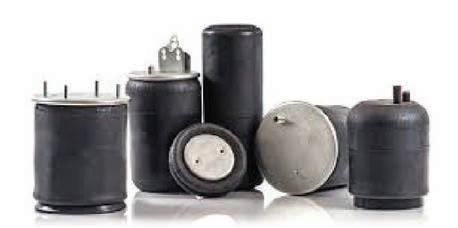




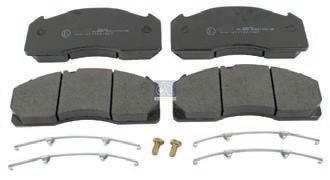
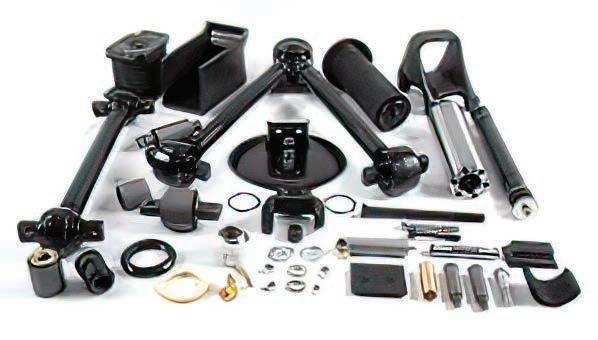





manager for the
ness Rob Roy Earthmoving, decided to
“Japan was good. Given it’s our wet season up here and we can’t move anywhere, it was a great time to set off on a quick snow-

boarding trip to Japan,” he said.
“We left Weipa when it was about 36 degrees and 100 per cent humidity.”
Roy is now back working around western Cape York and still catching plenty of fish and mud crabs in his spare time.





SMALL fleet operator Clayton
See, 50, was parked up at the Bowen South Roadhouse, beside the Bruce Highway when Big Rigs caught up with him recently.
See, who runs his company Doodeyman Transport, was near his Kenworth T409, towing a dog trailer just before nightfall.
“I am carrying recycled glass and road base and often do the run between Brisbane and Townsville,” he said.
See has one other truck and is based at Freshwater Point,

if he had a good boss.


“I am my own boss,” he said with a grin.
See said his small cartage business will travel far and wide for work.
His trucks carry quarry products, paper, waste, rock and road bases. He has worked on large projects around the state and can also do small local jobs.
See says the worst road he travels along is the section of the Bruce Highway between Sarina and Marlborough.
And he’s not on his lone
as the dreaded “Marlborough stretch”.
A truck driver for more than a decade, See has 12 years of experience in the transport industry.
He said he likes stopping at the Traveston Roadhouse south of Gympie. “It has good service and is a nice place to stop,” he said.
With his stocky build, I asked See if he’d ever played rugby league football.
But he said that he preferred the rival rugby union known as Rah Rah.











held pride of place at the launch of a gala boxing tournament sponsored by Morgan Transport.
The Pro-Am tournament in Townsville is dubbed the “Battle at the Port”, taking place on March 30 and hosted by Knuckles Boxing Club.
It will feature two pro bouts and about 10 amateur bouts including one women’s event.
General manager administration and compliance at Morgan Transport, Cameron Wright, arrived in the Kenworth.
“As Battle at the Port Boxing continues to gain momentum and recognition, through a beacon for aspiring boxers and seasoned fighters alike led by Matty Rooney who has a truck licence, this establishment has become synonymous with excellence in boxing training and development,” Wright said.
but also leave a legacy of support and camaraderie. In the dynamic world of boxing, where every match is a test of skill, endurance, and determination, partnerships forged through sponsorship serve as the cornerstone of progress and prosperity.”
Cameron has had decades of experience in the road transport industry and about 20 years ago was boss of the now defunct Townsville Towing when he was overseer of a very smelly job.






Boxers are from Townsville, Palm Island, Forest Beach, Ingham, Tully, Cairns and even as far away as Melbourne.
Big Rigs was invited to the launch for the event beside Ross Creek and across from the building where it will be held.
“The role of sponsors like Morgan Transport Group will remain integral to its success. By championing local sporting initiatives and investing in the communities they serve, sponsors not only contribute to the growth and development of the sport
It was to retrieve the carcass of a huge whale which had been found dead in waters south of Townsville.
“When the remains and bones were loaded onto the back of a truck, it was so putrid that workers and myself were sick,” he said.

 NHVR EXPERT DAVID HOURIGAN Chief safety and productivity officer
NHVR EXPERT DAVID HOURIGAN Chief safety and productivity officer
IN the continuous journey towards safer roads and responsible environmental practices, we released the draft Waste and Recycling Industry Code of Practice for Load Management (WLC) last month.
We encourage anybody who might have an interest to give us their feedback, so we can incorporate any necessary changes before the code is registered. is practical guide was developed with the help of industry to drive better safety outcomes in this important and extremely busy sector.
It does this by pinpointing some of the hazards that are commonly encountered in waste transport activities and outlines proven control
measures to reduce or completely avoid these risks. ink of it as a strategic plan for keeping operations safe and e cient. Like all sectors of the transport industry, managing risks on the road can only be achieved when oroad parties do their part, so this code is not just for transport operators.
If a business or organisation produces waste, or manages premises where waste is collected or delivered, or otherwise works with waste transporters, then it will be a party in the Chain of Responsibility (CoR) for the safe transport of that waste.
e code will help you to analyse hazards that exist within your activities and how to manage them.
One of the most important things you can do is to maintain close communication with other parties in the CoR, who share with you the primary duty to ensure safety.
Development of the WLC was suggested by the Waste and Recycling


THIS PRACTICAL GUIDE WAS DEVELOPED WITH THE HELP OF INDUSTRY TO DRIVE BETTER SAFETY OUTCOMES IN THIS IMPORTANT AND EXTREMELY BUSY SECTOR.”
Industry Association of Queensland (WRIQ), with the support of their associations in other states and the National Waste and Recycling Industry Council (NWRIC).
Members of these organisations provided great advice on e ective control measures and highlighted important hazards that have been identi ed.
As the period for providing feedback on the WLC draws to a close on March 29, it’s clear how important collaboration has been.
We will soon review your feedback to further re-

ne the WLC. Please note, submissions received after this date may be included in consideration of any amendments required.
ank you to everyone who has assisted with devel-


opment of this code so far.
Your participation is driving positive change in Australia’s waste and recycling transport sector, setting a foundation for safer and more sustainable practices for the future.
As we move forward, let’s continue to work together, embracing the changes and challenges ahead with a shared vision of safer roads and a cleaner environment.









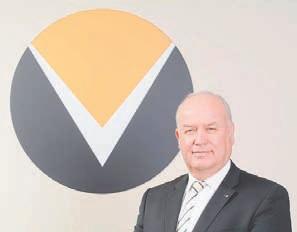 VTA COMMENT PETER ANDERSON CEO, Victorian Transport Association
VTA COMMENT PETER ANDERSON CEO, Victorian Transport Association
AS the arteries of our regional infrastructure, roads are the lifelines connecting towns, workplaces, and vital supplies.
Yet, despite their paramount importance, our roads are in a dire state, plagued by wear and tear, inadequate maintenance, subpar construction, and a lack of recognition of their true value.
e Victorian Transport Association (VTA) raises these issues as urgent calls to action for the betterment of our communities, economies, and safety.
Firstly, wear and tear on roads is inevitable. However, we must acknowledge the need for proactive planning and forward-based strategies to mitigate the impacts.
Simply blaming heavy vehicles and throwing money at repairs is insu cient. We need comprehensive plans that address the ageing infrastructure and the high volume of use our roads endure.
Maintenance programs are also sorely lacking. e cur-
rent system fails to recognise the depth of issues and the necessity of permanent repair crews stationed in regional areas.
It’s time to shift towards a model where permanent maintenance teams, integrated with VicRoads, address issues promptly, preventing the accumulation of unaddressed road defects.
Construction design lies at the root of many road issues. Historically inadequate surveying, poor topographical analysis, and substandard materials lead to premature breakdowns.
It’s imperative to raise our standards and invest in robust infrastructure that withstands the test of time and usage.
Productivity su ers when roads deteriorate. Trucks are not just vehicles but essential components of thriving communities.

As road quality declines, so do supply chain e ciencies, leading to increased operational costs and ultimately higher prices for consumers.
Investing in road infrastructure isn’t just a cost; it’s an investment in economic prosperity.
e question of responsibility looms large. While di erent levels of government over many successive terms have managed roads, the burden often falls disproportionately on local councils
ill-equipped to handle major road defects.
e blame game between politicians and road managers must end, with concerted efforts to address systemic issues and improve collaboration.
e cost of road damage is signi cant, both for the freight industry and individual truck operators.
While the industry contributes through road user charges and fuel excise, these funds often fail to materialise into tangible improvements.
Moreover, the increased maintenance costs for heavy vehicles exacerbate nancial strains on operators.
ere will never be enough money to fully maintain our roads to the standard that we all want them to be, but the real issue is how do we get the best bang for our buck to keep the roads maintained so it’s not costing operators time and money in repairs and maintenance to heavy vehicles to service our customers using the roads that are available.
What we’re proposing is that we change the process and forward look towards our road infrastructure being efcient and meeting the standard that we all expect.
ose roads need to work, they need to work well, and
people need to have condence to drive and not fear having to slow down from 100 to 60km/h.
Beyond monetary concerns, the deteriorating state of our roads re ects a fundamental misunderstanding of their value.
Our roads underpin economic activity, tourism, and social connectivity. Neglecting them jeopardises the growth and well-being of our communities, sti ing progress and impeding prosperity.
Road safety cannot be overlooked. While accidents are often attributed to driver error, poor road conditions
AS ROAD QUALITY DECLINES, SO DO SUPPLY CHAIN EFFICIENCIES, LEADING TO INCREASED OPERATIONAL COSTS AND ULTIMATELY HIGHER PRICES FOR CONSUMERS.”
contribute signi cantly to vehicle wear and tear, endangering lives and straining resources.
Merely addressing the symptoms won’t su ce; we need comprehensive reforms to ensure our roads are safe and sustainable for all users.
e issues plaguing Victoria’s roads demand urgent attention and concerted action. Band-aid solutions won’t sufce; we need systemic changes that address maintenance, construction, funding, and accountability.
e VTA urges stakeholders to prioritise road infrastructure investment, recognizing its pivotal role in our collective prosperity and well-being.
Failure to act risks not only economic repercussions but also compromises safety and quality of life for all Victorians. It’s time to pave the way for a brighter, smoother future on our roads.

WOMEN IN TRANSPORT
JACQUELENE BROTHERTON
Chair of Transport Women Australia
WITH the countdown on to our Transport Women Australia Limited Living the Dream Conference, the speakers and sponsors are being nalised and the board is extremely excited for a fantastic conference.
e conference is being held at the Hyatt Place, Essendon Fields, Melbourne, between May 30 and June 1. It kicks o with a pre-conference tour of Paccar, which includes lunch, and a concurrent session with Healthy Heads in Truck and Sheds.
We have wonderful keynote speakers: Cindy Parker, director of operations from American LLC from Arkansas and Ellen Voie, founder, Women in Trucking from Wisconsin.
We have three previ-
ous recipients of the Trish Pickering Memorial Award telling their stories, Hazel Whitmore – 2021, Merry Manton – 2022 and Sharon Middleton AM - 2023: recipients of the Driving the Di erence scholarships and fabulous female speakers from Volvo, NTI, Viva, the NHVR and many more.
For bookings for the conference, the booking code is https://www.trybooking.com/CONZX Follow us on our social media for continuing updates.
We have three nominations in the ATA Trucking Australia Awards and will be presenting a panel on the program as well as hosting our Annual Pre-Trucking Australia Lunch. See Y’all there.
Nominations are open for the new TWAL, the ‘Young Gunnette’ Award, this award is to recognise the achievements of upand-coming females in the transport and logistics industry.
e award is one of the ways TWAL continues to promote, motivate, and encourage young females who are making strides early
in their careers. is award is open to all who qualify. Entrants must be individuals who can display that they are contributing to the industry over and above paid employment/ business.
is can also include an individual who has demonstrated leadership on a matter relating to the industry and/or who has been involved in a signi cant initiative that has brought about positive change or added value to the industry and/or has inspiring qualities as an advocate of the industry.
In addition to the above, the candidate must be 30 years of age or younger on the date of entry opening, be an individual and not a business or group, be non-political and should not cause disrepute.
Please note: We are unable to accept nominees for members of state, federal, and/or local government. No self-nominations will be accepted. e winner of which will be announced that the Living the Dream Conference Awards Dinner on June 1.
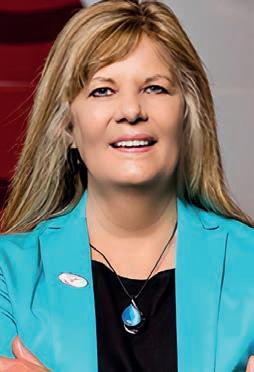
Nominations are also open for the Dream Mak er Award which will be presented the Transport Women Unite Red Ball on August 24 at the Festival of Transport at Alice Springs. is award is to recognise those in the industry who work behind the scenes and help those who front the organisation to achieve their dreams, whether it be an owner/operator, a family business, or a large company. Demonstrated commitment to their work, com-

pany, and the industry without seeking recognition, supportive and committed to helping others. No self-nominations will be accepted.
We are looking forward to having a large number of nominations and cannot wait to see the winners announced on the night. So,
get your entries in early and we will see you in Alice to celebrate.
For nominations forms for both awards, contact chair@transportwomen. com.au
For all Transport Women Australia Limited enquiries please contact chair@transportwomen.com.au.






































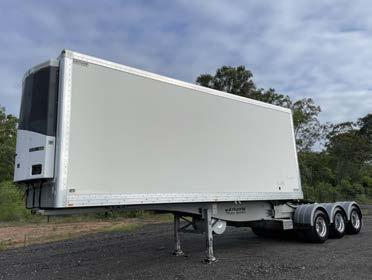




 34 PALLET DROP DECK B DOUBLE CURTAINSIDER COMBINATION
20-40FT SIDELIFTER
2023 HAULMARK 10 PALLET A-TRAILER $165,000 INCL GST
2016 GTB
45FT REFRIGERATED VAN $77,000 INCL GST
2012 VAWDREY 41FT EXTENDABLE FLAT TOP $99,000 INCL GST
2022 KRUEGER
D/DECK TAUTLINER MEZZ $165,000 INCL GST
2022 MAXITRANS 45FT FLAT TOP $121,000 INCL GST
2020 VAWDREY 45FT DRY PAN $154,000 INCL GST
2016 GTB A-TRAILER REFRIGERATED ROLLBACK $77,000 INCL GST
2016 GTB
45FT REFRIGERATED VAN $77,000 INCL GST
B-DOUBLE SIDE TIPPERS
DROPDECK EXTENDABLE
B-DOUBLE FLAT DECK CURTAINERSIDERS
34 PALLET DROP DECK B DOUBLE CURTAINSIDER COMBINATION
20-40FT SIDELIFTER
2023 HAULMARK 10 PALLET A-TRAILER $165,000 INCL GST
2016 GTB
45FT REFRIGERATED VAN $77,000 INCL GST
2012 VAWDREY 41FT EXTENDABLE FLAT TOP $99,000 INCL GST
2022 KRUEGER
D/DECK TAUTLINER MEZZ $165,000 INCL GST
2022 MAXITRANS 45FT FLAT TOP $121,000 INCL GST
2020 VAWDREY 45FT DRY PAN $154,000 INCL GST
2016 GTB A-TRAILER REFRIGERATED ROLLBACK $77,000 INCL GST
2016 GTB
45FT REFRIGERATED VAN $77,000 INCL GST
B-DOUBLE SIDE TIPPERS
DROPDECK EXTENDABLE
B-DOUBLE FLAT DECK CURTAINERSIDERS

preting fatigue legislation isn’t easy. is article is not intend ed as legal advice. Please seek legal advice if needed.
For drivers of fatigue regu lated heavy vehicles (weighing over 12 tonnes, combinations over 12 tonnes, or fatigue-reg ulated buses designed for over 12 adults including the driver), the Heavy Vehicle National Law (HVNL) fatigue provisions apply.
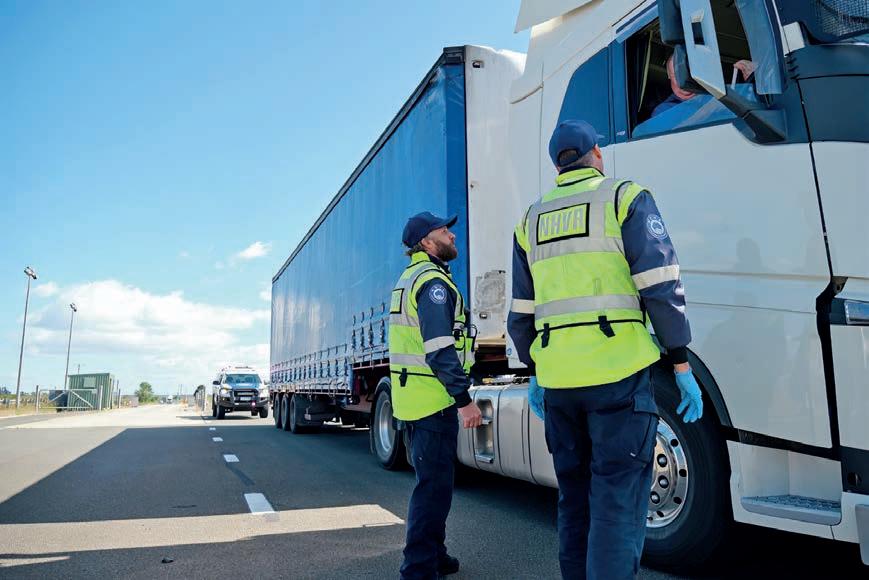
Let’s start with what should be a straightforward concept: the driver’s base. We all believe this must be recorded in your work diary (found on page 32), however, the legislation does allow the ability for no base to be recorded at all.
e de nition for base, of the driver of a heavy vehicle is:
1. e base of the driver of a heavy vehicle, in relation to particular work—
(a) is the place from which the driver normally does the work; but
(b) is, for the purposes of Chapter 6, the garage address of the vehicle if—
(i) the vehicle is a fatigue-regulated heavy vehicle; and
(ii) the driver is required under Part 6.4, in relation to that particular
work, to keep a work diary and to record the location of the driver’s base in the work diary, and has not done so.
Note –e driver of a fatigue-regulated heavy vehicle may not be required under Part 6.4, in relation to particular work, to keep a work diary and to record the location of the driver’s base in the work diary, if, for example—
• the driver is undertaking 100km work under standard hours
• the driver is working under a work diary exemption
2. or a driver who is a self-employed driver and an employed driver at di erent times, the driver may have one base as a self-employed driver under paragraph 1
and another base as an employed driver under that paragraph.
3. For a driver who has 2 or more employers, the driver may have a di erent base in relation to each employer under paragraph 1.
Let’s look at some examples:
Example 1: Mary, a selfemployed truck driver, works from her home address, 490 Taylors Road, Skye, Victoria.
When working for herself, the garage address of the truck is her base at 490 Taylors Road, Skye.
Sometimes, she does casual work for ABC Trucking driving their truck, so her base would be 120 Greens Road, Dandenong. Mary would need to note the date and ABC Trucking base in her work diary when working for

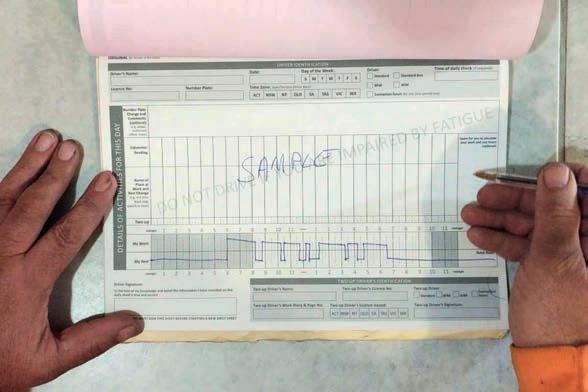
Let’s look at a trickier example.
ABC Trucking, and then note the date and her home address base when working for herself. Now, only those with special trucks probably have an actual garage to keep them in (we’re looking at some of you 9oh drivers...) but there is a de nition of the garage address in the HVNL: Garage address, of a heavy vehicle, means—
(a) for a heavy vehicle normally kept at a depot when not in use—the principal depot of the vehicle; or
(b) for a heavy vehicle not
Example 2: Tom lives at Goulburn. He is employed by ABC Trucking in Dandenong and drives their truck, which he keeps at his home on Sundays. When Tom takes leave for holidays, the truck is parked at the ABC Trucking depot, where it might be used by other drivers until Tom returns.
On Mondays, Tom drives the truck from Goulburn to ABC Trucking at 120 Greens Road, Dandenong, completing deliveries along the way. Working out of the Dandenong depot all week, he sleeps in the truck or stays with his brother nearby.
On Saturdays, he drives
but does not complete the work/rest pages while driving around Dandenong, as this is within the 100km radius of the garage address of the truck.
In this example, Tom could leave the base in his work diary blank, as the garage address can be used to identify his base. Clause 1(b) of the de nition takes e ect, speci cally 1(b)(ii) which is “the garage address of the vehicle” where the driver has not written in the base on page 32 and he is working within 100km of the base. is makes it di cult to prove roadside, but is not a breach. Having said that, Tom would not be able to have any entries at all in the base section on page 32 for





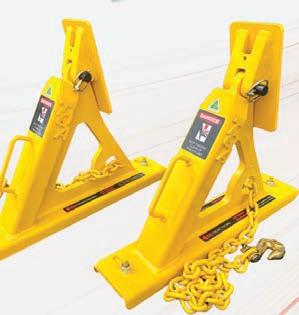
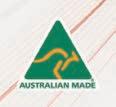



Across
1 Which thread is used for sewing (6)
8 To reject or renounce, is to do what (8)
9 What might we call a leg or an arm (6)
10 What do we call newly enlisted members of the armed forces (8)
11 What is a lively Spanish dance in three-four time (6)
12 Name a spring, or natural source of water (4)
13 What is offspring, or progeny (5)
16 What are young sheep (5)
19 To discontinue, is to do what (4)
21 Name the act of concealment (6)
22 Which breed of dog originated in Newfoundland (8)
23 What is a set of articles for any purpose (6)
24 Which gaseous element forms about four-fifths of the earth’s atmosphere (8)
25 Which plot of ground is devoted to the cultivation of flowers (6)
Down
2 What are spotted, leopard-like cats (7)
3 What is a picture, as of a scene (7)
4 To be of little breadth, is to be what (6)
5 What do we call bedding, rolled up so as to be easily carried (7)
6 Which term describes the greatest amount (7)
7 Name a scale of temperature (7)
13 Reykjavik is the capital of which island republic (7)
14 What is a day of rest and worhsip (7)
15 Name the great circle of the earth (7)
17 Who examines accounts (7)
18 Which fire was set alight on cracker night (7)
20 Name another term for a crowd (6)


















helped him to get a great job in the transport industry.
Brandon Ugle is a member of the indigenous community, hailing from the Minang tribe in Albany, WA.
e 28-year-old rst heard about the Frank Cardaci Traineeship Program at Cenmen.
He signed up for the program in 2022, starting out as a trainee freight o cer and quickly moving up through the ranks to become a driver.
“Before this job, I had no experience whatsoever in warehousing or transport,” he said.
longest I have stayed in one job, which shows how much I like it.”
As part of his traineeship, Ugle gained a wealth of on-thejob experience and achieved a Certi cate III in Supply Chain Operations from South Metropolitan TAFE.
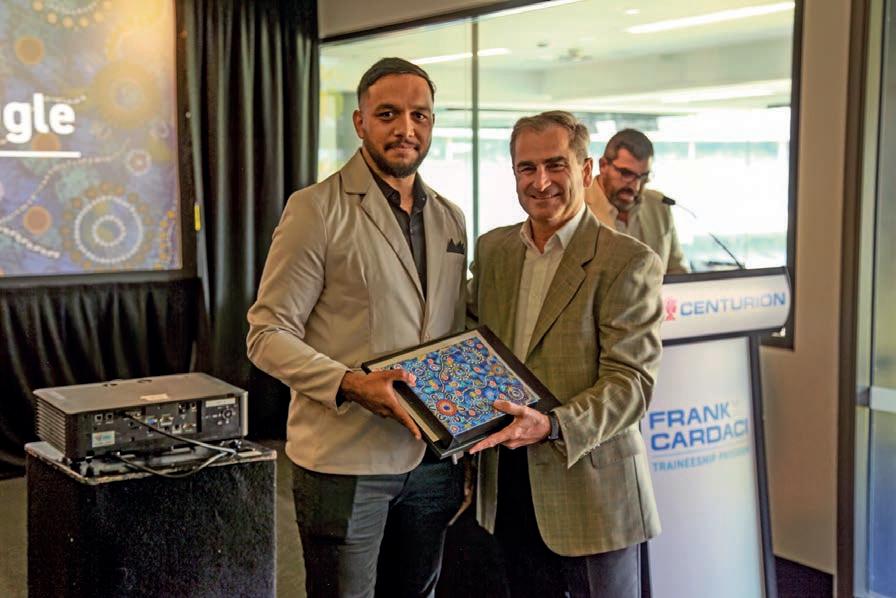
Other aspects of the program included education in nancial literacy, career goal setting, and mental health.
Ugle said that traineeships like Centurion’s are an important way to encourage more diversity in the trans-
“I think the industry is quite diverse overall, but I haven’t seen very many indigenous drivers,” he said.
“ e fact that we are a low percentage of drivers didn’t put me o applying though –it actually pushed me to go for it more.”
He encourages other young indigenous people to enter the transport industry, sharing some advice.
“If you’re applying for a job and you have no experi-
ence, it can be tough.
“With a traineeship, you get more out of it – more knowledge and more opportunity.
“My main advice is not to be scared to ask questions. If you’re not sure about something, always ask for more information.”
Named after one of the founders of Centurion, the Frank Cardaci Traineeship Program started as a scheme aimed solely at indigenous youth.
It has since been extended to any young person who has faced barriers to employment, regardless of their background.
Now in its eleventh year, Centurion’s Development Pathways business partner
Jason Tincknell said the program has helped many young people to kick o their careers.
“ ere are so many roadblocks that can prevent young people from getting a start,” he said.
“ is program is about giving people an opportunity and supporting them to grow their skills and their con dence, so that they can be good members of the community.
“ at is very important, regardless of what industry we’re in, but from an industry point of view we need to encourage and provide opportunities for new entrants.
“Our business has expanded a lot in recent years, and this program helps us grow while providing jobs for peo-




ple in the communities we work with.”
He added that Centurion puts a lot of care into nding the right roles for the right trainees.
“It’s not about hiring as many young people as we can, putting them in a job and seeing how they go,” he said.
“It’s about making sure we have the right t for our business, but it’s also about the individuals and making sure they are comfortable in their workplace and have a good experience.”
Ugle is far from the only success story the program has seen over the years.
“Anyone who is able to nish their traineeship has generally been through a few ups and downs,” Tincknell continued.
“Seeing their resilience, their ability to overcome barriers and take on the advice from their mentors is amazing.”
He said getting the mentees

through their rst year can often be the biggest challenge.
“If they haven’t worked before, and they go straight into full-time work, that motivation can start to wane a bit,” he said.
“ ere was one young fellow in particular, he was struggling with coming to work.
“We were able to have a chat with him and help him see what he had achieved in the program so far, and that helped to reinvigorate him.”
Now over a year after their chat, that young man has graduated and is one of the highest performers in his team.
“When you see students come out the other end and they start to take responsibility for their own journey, that’s when you know the program has been bene cial.”
If you are interested in applying for the Frank Cardaci Traineeship Program, contact Centurion’s Learning and Development Team at learning@ centurion.net.au.
WHEN Alysha Douma last chatted to Big Rigs, she revealed her ambitions of getting into linehaul work – and now she’s done exactly that, carrying cars across Queensland, with her two fur babies coming along for the ride.
Douma, 37, had spent 15 years working in the science field before getting her HR licence in June 2021, and eventually progressing to her MC last September.
She did local car carrying work for around two years, driving an Isuzu FSD with a four-car trailer.
That was up until earlier this year where she secured a new role with Eurotrans, working out of their Willawong depot – a suburb in the south of Brisbane.
She’s now behind the wheel of a 2016 Volvo FH16 Globetrotter, carrying six to seven cars at a time, predominantly to dealerships and PrixCar depots.
“It’s been nearly three months so I started the year off with a bang,” said Douma.
“Being in the bigger truck, it has been another learning curve trying to work out all the car placements when loading, understanding the new widths and placement of the pillars. You also need to concentrate so much more on height and weight distribution too, because



With her two dogs Apollo and Cinco.

BEING IN THE BIGGER TRUCK, IT HAS BEEN ANOTHER LEARNING CURVE TRYING TO WORK OUT ALL THE CAR PLACEMENTS WHEN LOADING.”ALYSHA DOUMA
you’re travelling long distances. “The Volvo is so much more comfortable than the old truck. Because everyone has their own truck and we’re not having to share it, it’s like your home away from home. I’ve set it all up with my own bedding and everything. The boss wants our trucks to be our own space.”
Douma travels predomi-
Images: Alysha Douma
nantly to Townsville, Mackay and Cairns – with Cairns being the furthest run, at approximately 1700 kilometres each way.
And Douma says she’s adjusted well to the travel. “I was prepared for it, I’d been around the interstate drivers so I knew what I was getting into. I’ve also grown up in a camping and travelling family, so being on the road and having showers at roadhouses doesn’t feel foreign to me.”
As for her typical week, “We leave on the Monday morning and usually get back on the Friday night,” said Douma, adding that her dogs – a cavalier named Apollo and a spoodle named Cinco are absolutely loving her new gig.
“As soon as I start packing my bags, the dogs are right there. They’ve adjusted to it re-
ally well and are super patient while I’m busy out there loading and unloading cars. They’re quite into the life – and we somehow all fit in the bed!
“A lot of big companies don’t let you have your dogs in the truck, but this boss didn’t mind at all. I keep my cab clean, I keep the dogs clean and so far I haven’t any issues with that. I’m respectful at depots too. They never come out of the truck at the depots so they don’t interfere with anyone’s work.
“I’ve now become known as the lady with the dogs,” she laughed. “I also plan my stops so there are places I can go for a walk with the dogs. I stop in Gympie a lot so we can go to the dog park there too.
“My dogs are really good company and I’m not having to race home to see them because they’re already with me.”

